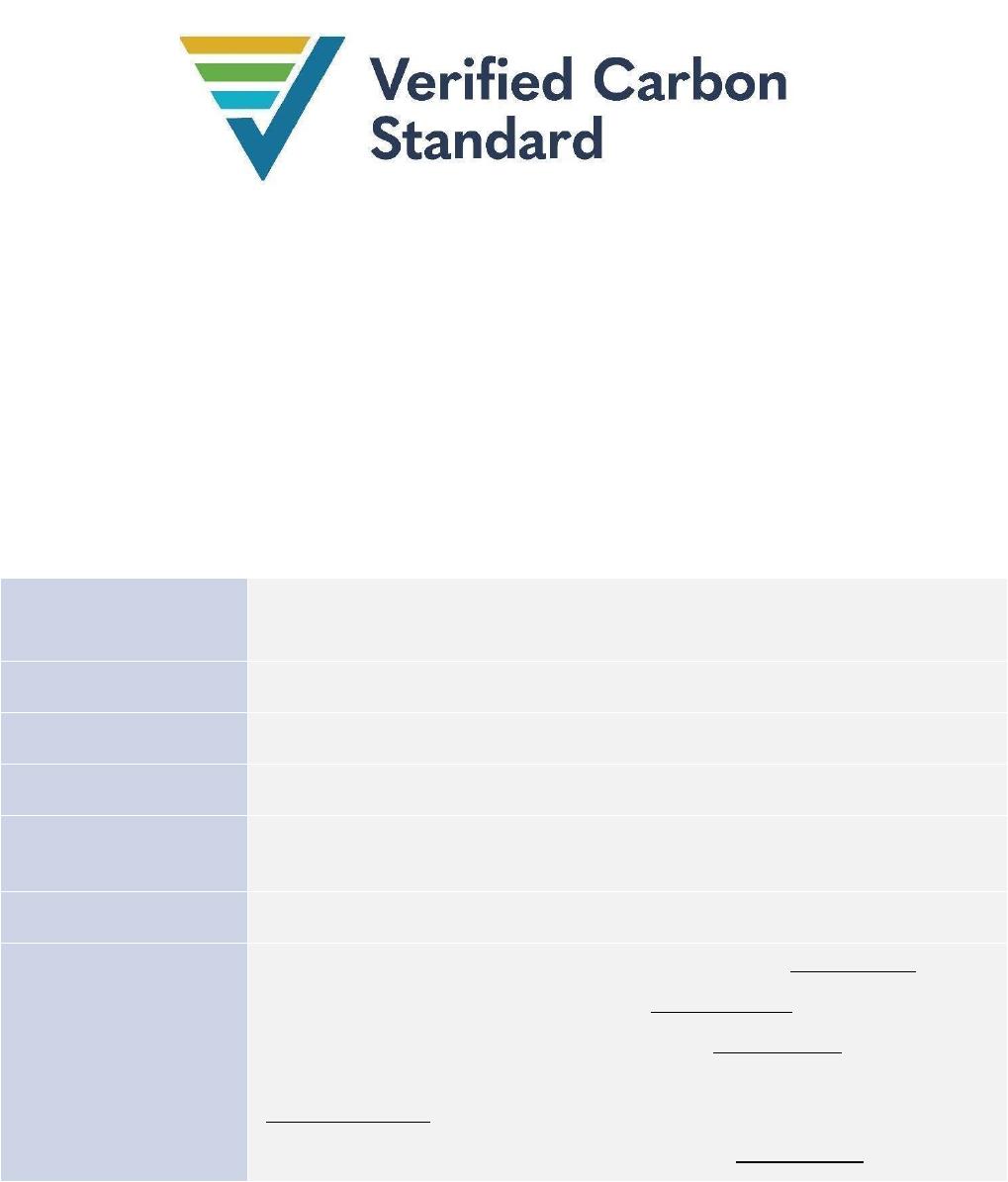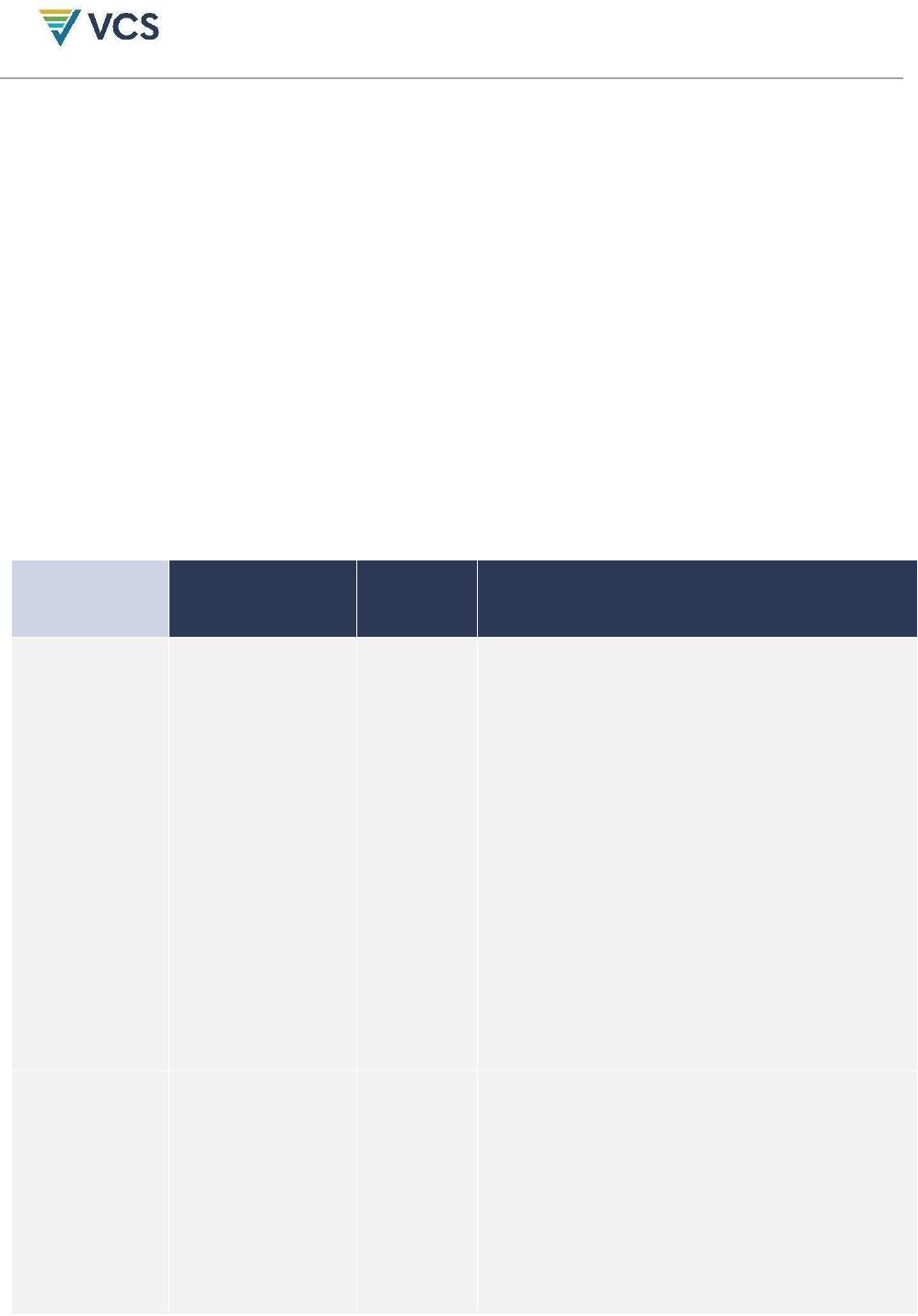METHODOLOGYFORIMPROVEDFORESTMANAGEMENTTHROUGHTARGETED,SHORT-TERMHARVESTDEFERRALDocumentPreparedbyNCXTitleMethodologyforImprovedForestManagementthroughTargeted,Short-TermHarvestDeferralVersion1.0DateofIssue17March2021TypeMethodologySectoralScopeSectoralScope14Agriculture,ForestryandOtherLandUses(AFOLU);ImprovedForestManagement;ExtendedRotationAgePreparedByNCXContact2443FillmoreSt.#380-1418,SanFranciscoCA94115.www.ncx.com.ZackParisa,ChiefExecutiveOfficer,NCX(zack@ncx.com)NanPond,PhD,ScienceDirector,Forestry,NCX(nan@ncx.com)GordonVermeer,ProgramDirectorandChiefFinancialOfficer,NCX(gordon@ncx.com)JenJenkins,PhD,ChiefSustainabilityOfficer,NCX(jen@ncx.com)Methodology:VCSVersion4.0RELATIONSHIPTOAPPROVEDORPENDINGMETHODOLOGIESApprovedandpendingmethodologiesundertheVCSProgramandapprovedGHGprogramsthatfallunderthesamesectoralscope(14–Agriculture,ForestryandOtherLandUses-AFOLU)andAFOLUprojectcategory(ImprovedForestManagement-IFM),werereviewedtodeterminewhetheranexistingmethodologycouldbereasonablyrevisedtomeettheobjectiveofthisproposedmethodology.Fourmethodologieswereidentifiedandaresetoutbelow.ThesemethodologiescouldnotbereasonablyrevisedforseveralreasonscitedinthecommentssectionofTable1-1:SimilarMethodologies.Table1-1:SimilarMethodologiesMethodologyTitleGHGProgramCommentsVM0003MethodologyforImprovedForestManagementthroughRotationAgeExtensionVCSVM0003usesaprojectmethodforbaselineandadditionalitydetermination,whereastheproposedmethodologyusesaperformancemethod.Additionally,unlikeVM0003,thismethodologyclarifiesuseofremotesensingdataderivativestoincreasemeasuringandmonitoringefficiencyandincorporatestonne-yearaccountingtodetermineandassureequivalentimpacttopermanentstorage.Finally,VM0003reliesongrowthandyieldmodelsforthedeterminationofcarbonstocking,whereasgrowth/yieldmodelsarenotnecessaryinthismethodologybecauseofthequantificationmethod.VM0012ImprovedForestManagementinTemperateandBorealForestsVCSVM0012usesaprojectmethodforbaselineandadditionalitydeterminationwhereastheproposedmethodologyusesaperformancemethod.Additionally,unlikeVM0012,thismethodologyclarifiesuseofremotesensingdataderivativestoincreasemeasuringandmonitoringefficiencyandincorporatestonne-yearaccountingtodetermineandassureMethodology:VCSVersion4.0equivalentimpacttopermanentstorage.VM0012reliesongrowthandyieldmodelsforthedeterminationofcarbonstockingwheregrowth/yieldmodelsarenotnecessaryinthismethodology.Finally,VM0012isnotapplicabletoworkingforests,suchasplantationforests,wherethatisnotarestrictionimposedbythismethodology.VM0034CanadianForestCarbonOffsetMethodologyVCSVM0034usesaprojectmethodforbaselineandadditionalitydetermination,whereastheproposedmethodologyusesaperformancemethod.Additionally,unlikeVM0034,thismethodologyclarifiesuseofremotesensingdataderivativestoincreasemeasuringandmonitoringefficiencyandincorporatestonne-yearaccountingtodetermineandassureequivalentimpacttopermanentstorage.Finally,VM0034reliesongrowthandyieldmodelsforthedeterminationofcarbonstockingwheregrowth/yieldmodelsarenotnecessaryinthismethodology.Underdevelopmentattimeofwriting(FamilyForestCarbonProgram,TNCandAFF)MethodologyforImprovedForestManagementVCSThemethodologyunderdevelopmentreliesonmeasurementandcorrelationofprojectandcompositecontrolplotsthatformtheproject’sbaseline.Incontrast,thismethodologyusesapredictivemodellingapproach,basedonUSFSFIAdata,todevelopthebaselinescenarioandforthedeterminationofadditionality.Additionally,thismethodologyincorporatestonne-yearaccountingtodetermineandassureequivalentimpacttopermanentstorage.Methodology:VCSVersion4.0CONTENTS1SOURCES..............................................................................................................62SUMMARYDESCRIPTIONOFTHEMETHODOLOGY............................................63DEFINITIONS.........................................................................................................74APPLICABILITYCONDITIONS..............................................................................85PROJECTBOUNDARY........................................................................................106BASELINESCENARIO.........................................................................................117ADDITIONALITY..................................................................................................138QUANTIFICATIONOFGHGEMISSIONREDUCTIONS&REMOVALS................138.1BaselineEmissions.............................................................................................................138.2ProjectEmissions...............................................................................................................158.3Leakage............................................................................................................................168.4Uncertainty........................................................................................................................188.5NetGHGEmissionReductions/Removals...................................................................209MONITORING....................................................................................................209.1DataandParametersAvailableatValidation............................................................209.2DataandParametersMonitored..................................................................................229.3DescriptionoftheMonitoringPlan................................................................................2910REFERENCES.......................................................................................................3011APPENDIXA:BASELINECOMMONPRACTICEHARVESTMODEL....................3211.1MathematicalRepresentationofModelForm............................................................3211.2FinalHarvestRiskModelForm.........................................................................................3311.3ModelInputs.....................................................................................................................3511.4UpperboundsonCarbonatRisk...................................................................................39Methodology:VCSVersion4.011.5ReferencesUsedinBaselineModelDevelopment.....................................................4112APPENDIXB:BASELINEMODELFITTINGDATASETCOMPILATION..................4312.1BaselineModelTrainingandValidationDataset........................................................4312.2NationalForestInventoryData......................................................................................4312.3CovariateData................................................................................................................4412.4References........................................................................................................................4513APPENDIXC:VALIDATIONANDVERIFICATIONGUIDANCE..........................4513.1Validation..........................................................................................................................4513.2Verification........................................................................................................................461SOURCESNosourcesarereferencedinthisdocument.Whilewehavecitedreferencesinsupportofparticularareasofthesciencerepresentedinthismethodology,therearenoexistingmethodologiesorprojectsthatformamotivationorbasisofthiswork.2SUMMARYDESCRIPTIONOFTHEMETHODOLOGYTable2-1:ApplicationofStandardizedMethodAdditionalityandCreditingMethodAdditionalityPerformanceMethodCreditingBaselinePerformanceMethodThemethodologyisapplicabletoprojectswhereinparticipantselecttodefertimberharvestsforaspecifiedlengthoftime;therefore,projectsusingthemethodologyareconsideredundertheimprovedforestmanagement(IFM)subclassofextendedrotationage(ERA)projects.Themethodologyreliesonaperformancemethodforthedemonstrationofadditionalityandselectionofthecreditingbaseline.Harvestdeferrals,andanyassociatedstockchanges,aremonitoredthroughplot-basedfieldmeasurementsofcarbonstockingthatinformboththebaselinescenarioandtheprojectscenario;thesearerepeatedmeasures,withthesameplotsmeasuredatthebeginningofthereportingperiod,timet0,andaftercompletionofthereportingperiod,timet1.Spatiallyexplicitremotesensingdataoftheprogramareaandadditionalfieldmeasurementmayalsobeemployedtoenhancerepeatedfield-basedmeasurementsandtodetectareasofdisturbanceduringtheactivityperiod(i.e.,betweent0andt1).Therefore,thisisaperformance-basedmethodologythatreliesonmeasurementstodemonstrateharvestdeferrals,andassociatedGHGemissionreductions/removals,inrelationtoabaselinescenario.Assuch,growthandyieldmodelingthatisnecessaryinmostIFMprojecttypesisnotemployed.Themethodologyalsousesatonne-yearaccountingapproachtopermanence(whereatonne-yearreferstoonemetricton(MT)ofCO2e,sequesteredforoneyear).Theconversionratebetweentonne-yearsandpermanenttonneshasbeenprovidedinthemethodologyandhasbeenseparatelyapprovedbyVerra.Thetonne-yearaccountingapproachallowsforequivalencetopermanenttonnesonanannualbasisandthereforepermanenceriskassessmentandbufferpoolcontributionsarenotrequired.Itisexpectedthatprojectsutilizingthismethodologywilltypicallyemployagroupedprojectapproach,therebyopeningcarbonmarketstosmaller-sizelandownerswithhistoricallylowratesofparticipation.Smallandmid-sizeforestlandownerscanparticipatenotonlyduetolowMethodology:VCSVersion4.07fixedcostsbutalsoduetoflexibilityinprojectstructure.Theinclusionofsmallandmid-sizeforestlandowners(holdingsoflessthan2000hectares)isnottypicallypossibleduetotherequirementsofmanyIFMmethodologies,butlandownersatthesesmallsizeclassesrepresentmillionsoflandownersandhundredsofmillionsofhectaresofforestlandintheUnitedStates.Themethodologyiscompatiblewithplantationforests,unlikemostotherIFMmethodologies.Therelativelyconsistentforestmanagementpracticesandharvestbehaviorassociatedwithplantationforestsfitswellwithaharvestdeferralstrategybecausethoseattributesfacilitatethismethodology’sapproachtotheselectionofacreditingbaseline(specifically,itsbusinessasusual(BAU)estimationtechniques).Further,therapidbiologicalgrowthratesofmanyplantationspeciesatorneartheirconventionallyoptimalrotationage(e.g.,Southernyellowpineatages25-30)alsomakethemwell-suitedforcarbonsequestrationpurposes.Finally,whilethismethodologyisnotablyapplicabletoplantationforesttypes,allforesttypesunderallownershiptypesareeligibletoparticipateintheproposedmethodology,ifitcanbedemonstratedthatallapplicabilityconditionscanbemet.3DEFINITIONSActivityperiodTheintervaloftimeduringwhichtheprojectactivityisundertakenonaparticipatingproperty.InstanceSeeProjectActivityInstance(Instance)”inVCSProgramDefinitionsv4.1.Inthismethodology,aninstanceisaparticipatingpropertythatsharesanactivityperiodwithotherparticipatingproperties,meaningtheystartandfinishtheprojectactivityatthesametimeasoneanother.Individualinstancesmayengageinoneormoreactivityperiods,i.e.oneormoreyearsofharvestdeferral,andthereforenotallinstanceswouldhavethesamenumberofyearsofharvestdeferral.LoggingSlashDeadwoodresidues(includingfoliage)leftontheforestflooraftertimberremoval.ParticipatingpropertyForestedareameetingtheapplicabilityconditionsundersection4;distinguishablefromsurroundingforestlandbyvirtueofitsownershipormanagementbyaparticipant,asrelevant;enrolledvoluntarilybytheparticipantintheproject.PersistenceAdditionalcarbongeneratedthroughoneormoreyearsofharvestdeferralthatcannotreasonablybeexpectedtobeharvestedatafuturedateduetooperationalconstraints.ProgramareaMethodology:VCSVersion4.08Thegeographicregionofapplicabilityforparticipatingproperties,asdeterminedbytheprojectproponentconsideringtheprojectproponent’sabilitytosatisfythismethodology’srequirementsinthatgeographicregion.Definedforeachindividualprojectdevelopedunderthismethodology.Anon-inclusivelistofexamplesofaprogramareaforaprojectunderthismethodologycouldbeoneorseveralU.S.states,onecountry,oroneormoreLevelIIEcoregions.ProjectactivityseeVCSProgramDefinitionsv4.1.Inthismethodology,theprojectactivityisharvestdeferral.ProjectparticipantorParticipantApartywhohastheright,withouttheconsentofanythirdparty(orinthecaseofanauthorizedrepresentativeofthelegalowner(s),withoutanyfurtherpermissionorconsentfromthelegalowner(s)),to(i)harvest,ordefertheharvestof,thetimberonalllandwithintheparticipatingproperty,subjecttoconstraintswithinthemunicipality,county,state,and/orcountryinwhichsuchpropertyislocatedandapplicablestateandfederalenvironmentallawandregulations,and(ii)selltoathirdpartyallenvironmentalattributesandrightstomakeenvironmentalclaimsrelatedtosuchharvestordeferredharvest.Itisunderstoodthatsuchrightsmaybeheldbydifferenttypesofparties,includingbutnotlimitedtopropertymanagers,timberrightsowners,feesimpleowners,andholdersofanyotherformoflandtenurethatincludestherightsspecifiedherein.Inthecaseofprivately-ownedforestsintheU.S.,themostcommonrelevantformoftenurewouldtypicallybefeesimpleownershipevidencedbypossessionoftitletotheasset.4APPLICABILITYCONDITIONSThismethodologyappliestoprojectactivitiesthatreducegreenhousegas(GHG)emissionsinmanagedforestsrelativetoabaselinescenariooveranactivityperiod,throughharvestdeferralstoextendcuttingcycles.Theactivityperiodmaybeasshortasoneyearbutmayalsobelonger.Thebaselinemustberecalculatedforeachpropertyandactivityperiod,pertheconditionsbelow.Theprojectactivitymaybereferredtoas“harvestdeferral.”Themethodologyisapplicabletoprojectswhereinparticipantselecttodefertimberharvestsforaspecifiedlengthoftime;therefore,projectsusingthemethodologyareconsideredundertheimprovedforestmanagement(IFM)subclassofextendedrotationage(ERA)projects.Thismethodologyisapplicableunderthefollowingconditions:1)Participatingpropertiesaresubjecttotimberharvestinginthebaselinescenarioduringtheactivityperiodasdeterminedviaabusinessasusual(BAU)assessment.Thisshouldbeconductedforeachactivityperiodtore-assessadditionality.2)Participatingpropertiesqualifyasforestsandmustremainforestswhileimplementingtheprojectactivity.3)Theprojectparticipanthascontrolovertheparticipatingproperty,perthedefinitionofParticipantsprovidedintheSection3above.Methodology:VCSVersion4.094)Theprojectproponentmustbeeitheraprojectparticipantoraninterestedpartywithanagreementtoimplementtheprojectonbehalfoftheprojectparticipant(s).5)Therearenoencumbrances,regulatoryorotherwise,ontheparticipatingpropertythatwouldimpairtheparticipant’sabilitytoharvest.6)Theparticipatingpropertyfallswithintheprogramarea.7)Allforestedpropertywithintheprogramarea(i)thatisownedbyaparticularsetofbeneficialowners(whetheranindividual,family,legalentity,orotherwise)or(ii)overwhichasinglepropertymanagerhasbeengivenlegalmanagingauthorityonbehalfofaparticularownerorsetofowners,isenrolledintheprojectandisconsidereda“participatingproperty”pertheDefinitionssectionabove.Participatingpropertiesarenotrequiredtohaveanauthorizedmanagementplanorprograminplace.Toachieveimprovementoverthecreditingbaseline,harvestsmustbedeferredinwholeorinpartrelativetotheamountexpectedtoberemovedundertheBAUassessment.Performance(i.e.,harvestinglevels)maybeassessedthroughacombinationofremotesensingdataandfieldmeasurement.Thegeographicapplicabilityofthemethodologyislimitedonlybytheavailabilityofappropriatedatasourcesandquantificationtechniques.ThemethodologyspecifiesaprocessforestablishingadynamicperformancebenchmarkthatisapplicableintheUnitedStates(duetodataavailability),butthemethodologymayapplytoprojectslocatedincountrieswhererelevantdatasourcesareavailableandwhereallotherrequirementsofthismethodologycanbemet.1ForGroupedProjects,thebeloweligibilitycriteriaapplytonewinstancesthatareaddedtotheprojectfollowinginitialvalidationoftheproject.Newinstancesmust:●Meetallapplicabilityconditionslistedabove;●Belocatedinthesameprogramareaasallotherinstancesincludedintheproject;●Undertakethesameprojectactivityastheinitialinstancesandbeassessedusingthesamequantificationmethods.ForGroupedProjects,themaximumnumberofyearsallowedforagiveninstanceisthatoftheprojectcreditingperiod;instancescanenrolinnewprojectsornewcreditingperiodsaslongastheycontinuetomeetallapplicabilityconditions.Thismeansthatthemaximumharvestdeferralallowedisequaltotheprojectcreditingperiod,however,thebaselinemustberecalculatedforeachpropertyandactivityperiod.1NotethatapplicationofthismethodologyincountriesotherthantheUnitedStateswouldrequirearevisiontothemethodologyforinclusionof,forinstance,relevantbiomassestimationtechniquesandmodificationstothebaselinescenarioselectionprocedure.Methodology:VCSVersion4.0105PROJECTBOUNDARYThespatialextentoftheprojectboundaryencompassesallparticipatingpropertieswithinaprogramarea.ThecarbonpoolsincludedorexcludedfromtheprojectboundaryareshowninTable5-1:SelectedCarbonPoolsbelow.Table5-1:SelectedCarbonPoolsSourceIncluded?Justification/ExplanationAbove-groundtreebiomassYesRequiredpoolsubjecttosignificantchangeduetotheprojectactivity.Above-groundnon-treebiomassNoNotrequiredduetoinsignificance.Below-groundbiomassNoConservativeexclusionaspoolislikelytoincreaseduetotheprojectactivity.LitterNoNotrequiredduetoinsignificance.DeadwoodNoNotrequiredasloggingslashisnotexpectedtoincreaseasaresultoftheprojectactivity.SoilNoNotrequiredduetoinsignificance.WoodProductsNoNotrequiredasharvestdeferralleadsonlytoashiftintheharvestedwoodproductsdecaycurve,whoseimpactdiffersdependingonthenumberofyearsharvestisdeferredduringandafterparticipation.ThegreenhousegasesincludedinorexcludedfromtheprojectboundaryareshowninTable5-2below.Table5-2:GHGSourcesIncludedInorExcludedFromtheProjectBoundarySourceGasIncluded?Justification/ExplanationBaselineFossilfuelemissionsCO2NoConservativelyexcluded–baselineaccountingdoesnotincludeemissionsfrommachineryusedinharvestingCH4NoConservativelyexcluded–baselineaccountingdoesnotincludeemissionsfrommachineryusedinharvestingMethodology:VCSVersion4.011N2ONoConservativelyexcluded–baselineaccountingdoesnotincludeemissionsfrommachineryusedinharvestingProjectFossilFuelEmissionsCO2NoSameasforbaselinescenarioCH4NoSameasforbaselinescenarioN2ONoSameasforbaselinescenario6BASELINESCENARIOForparticipatingproperties,themostplausiblebaselinescenarioisacommonpracticeharvestasdeterminedthroughabusiness-as-usual(BAU)assessment.Thespecificamountof“carbonatrisk”ofharvestshouldbedeterminedforeachparticipatingpropertyusingabaselinemodelconstructedasdefinedinthefollowingsectionandAppendicesAandB.Thebaselinescenarioshouldbereconstructedforeachactivityperiodduringacreditingperiodusingthebestavailableinformationandthereforerepresentsadynamicperformancebenchmark.Thisensuresthatthebaselinescenarioiscontinuallyevaluatedtoensurevaliditybasedontheparticipatingpropertiesduringeachactivityperiod.Todevelopthecommonpracticeharvestforeachparticipatingproperty,projectproponentsmustfollowthebelowstepstoestimatetheprobabilitythatagivenhectarewouldbeharvestedduringtheactivityperiod,andwhatproportionofthestandingcarbonwouldbeexpectedtoberemoved.Thesetwovaluescanbecalculatedthroughasingleunifiedbaselinemodel(asdescribed,forexample,inAppendixA)orthroughaseriesofmodelsorempiricalevidence(e.g.managementhistoryfromaparticipatingproperty).Commonpracticeharvestbehaviorshouldbecalculatedonafinescaleforeachparticipatingproperty(e.g.,half-hectareresolution).Thesumofthecarbonatriskacrossallhectaresoftheparticipatingpropertieswillgeneratethecarbonatriskofremovalduetoharvestingduringtheactivityperiod.Intheeventthereisanexistingexercisableoptionfortimberpurchaseonthelandinquestion,thelikelihoodofharvestmaybeappropriatelysetat100%.Intheeventthereisawrittenharvestplanfortheproperty,thismaybeusedtoprovidetheestimateofproportionofstandingcarbonexpectedtoberemovedinaharvest.Baselinemodelsshouldcontainstepstoexcludefromtheestimateofcarbonatriskanyportionsofparticipatingpropertiesthataresubjecttolegalconstraintsonharvesting;thismayincludebutisnotlimitedtoprotectedareassuchasthosecoveredbyconservationeasementsorlegalrestrictions(aspertheApplicabilityconditions).Baselinemodelsshouldalsocontainstepsthatpreventproperty-levelpredictedharvestamountsfromexceedingoperationalharvestlimits,bothforlogisticalreasons(i.e.inoperableslopedterrain)aswellasregionalsupplychains.TheseshouldbederivedfromthepublishedliteratureandmaybeMethodology:VCSVersion4.012supplementedwithparticipant-providedinformation;SeeAppendixAforanexampleimplementation.Forsomeproperties,specificallythosewithregionallyuniquemarketconditions,orparticularlylargeinarea,thereisanexpectationthatharvestdeferralrelativetothebaselinewouldresultinpersistentcarbononthepropertyinsubsequentyears.Thisisthecasewhenalandownerisonlyabletoharvestacertainabsoluteamountofvolumeinagivenyear,duetolegal,market,oroperationalconstraints.Deferralofsomeorallofthatharvestedvolumeinayeardoesnotresultindoublingthecarbonatriskinthefollowingyear,butinsteadamoreconsistentestimateofcarbonatrisk(subjecttoanupdatedbaselinecalculation,perthemethodology)andsomeamountofvolumeretainedonthelandscapeforamuchlongertimeperiod.Inthiscase,thebaselineincreasesbecauseofpreviouslyaccruedgrowth,butthebaselinedoesnotsolelyaccountfortheadditionalityofthispersistence.Theprojectscenarioinsubsequentyearsshouldincludetheimpactsofpreviousdeferralasacomponentofthecarbonatriskandasanestimateofabovegroundlivetreebiomassthatcanbequantifiedandcredited,andthiscanbecontinuedaslongasthatpropertycontinuestobeenrolledinconsecutiveactivityperiods.Themethodologydoesnotprescribeaspecificmodeltoderivethecommonpracticeharvestandassociatedcarbonatrisk.However,anymodelusedtoestimatethepercentagelikelihoodofharvestoccurringmustfitwithinthegeneralframeworkdescribedbyPrestemon&Wear(2000):Generalizedframeworkforprobabilityofharvest𝑃𝑃𝐻𝐻=ƒ�𝑉𝑉𝑇𝑇,𝑉𝑉𝑁𝑁𝑁𝑁,𝐶𝐶𝐻𝐻𝐺𝐺�Where:PHProbabilityofharvest(rangingfrom0-1)VTTimbervalueofthestand(monetaryunitsorvolume)VNTNon-timbervalueofthestand(monetaryunitsorvolume)CHCostofharvest(monetaryunits)GGroupingtermthatdenotesforeststandswithsimilarresponsesNotethattheunitsforthisframeworkwilldependontheprecisespecificationofthemodelandwhatvariablesareusedtodescribevalueandcost;examplesofpossibleunitsareprovidedinthetable.Additionalinformationandanapplicationofthegeneralstructureabovecanbefoundin(Table11-1)ofAppendixA:BaselineCommonpracticeharvestmodel.Predictedharvestvolumes,usedtoestimatetheproportionofcarbonthatwouldberemovedinaharvest,mustbebasedonregion-andforesttype-specificnormalsilviculturalMethodology:VCSVersion4.013implementationsasobservedinanauthoritativesourcesuchasnationalforestinventorydata,peer-reviewedpublications,orgovernment/NGOreports;silviculturalimplementationsmayalsobeempiricallyderivedfromnationalforestinventoryorotherrepeatedmeasurementsintheregionofinterestduringmodeldevelopment.Inputstothemodelmustbegroundedinacademicresearchand/orempiricalevidence.AppendixA:BaselineCommonpracticeharvestmodeldescribesonesuchpredictivemodelthathasundergoneexpertreviewandthathasbeenapprovedforuseinthecontextofthismethodology.Theoutputofthispredictivemodel,carbonatriskofharvestduringanactivityperiod,formsthebaselinescenarioforprojectsutilizingthismodel.Shouldaprojectproponentchoosetodevelopanalternativemodelforuseasadynamicperformancebenchmark,theprojectproponentmustdevelopanewmoduleforapplicationwithinthismethodologyandsuchbenchmark/modulemustundergotherequiredstepsformethodologymoduleapprovalinconsultationwithVerra.7ADDITIONALITYThismethodologyusesadynamicperformancemethodforthedemonstrationofadditionality.Step1:RegulatorySurplusProjectproponentsmustdemonstrateregulatorysurplusinaccordancewiththerulesandrequirementsregardingregulatorysurplussetoutinthelatestversionoftheVCSMethodologyRequirements.Step2:PerformanceBenchmarkTheproceduredescribedinSection6providesadynamicperformancebenchmarkintheformofcarbonatriskofremovalduetoharvestingthatwouldoccur,intheabsenceofcarbonfinance,duringtheactivityperiod.Thisperformancebenchmarkformsthebaselinescenariofortheactivityperiod.Deferralofharveststhatwouldoccurundertheprojectscenario,asquantifiedinSection8,aredeemedadditional.8QUANTIFICATIONOFGHGEMISSIONREDUCTIONS&REMOVALSThemethodologyquantifiestheGHGimpactofharvestinglesstimberonparticipatingpropertiesduringtheactivityperiodthanwouldbeharvestedunderthebaselinescenario.Reducingtheamountoftimberharvestedincreasestheaverageageofforestsrelativetothebaselinescenariowhichalsoincreasestotalcarbonstoragerelativetothebaselinescenario.8.1BASELINEEMISSIONSForeachactivityperiod,thebaselinescenarioisquantifiedbysummingtheBAUharvestassessmentsofallparticipatingpropertiesintheprogramarea.Methodology:VCSVersion4.014Stockchangeinthebaselinescenarioabovegroundlivetreebiomasscarbonpooliscalculatedasfollows:∆𝐶𝐶𝐶𝐶2𝑏𝑏𝑏𝑏𝑏𝑏,𝑡𝑡=�(1+𝐺𝐺𝑏𝑏𝑏𝑏𝑏𝑏,𝑡𝑡,𝑖𝑖)∗𝐶𝐶𝑡𝑡0,𝑖𝑖𝑛𝑛𝑖𝑖=1∗(1−𝑟𝑟𝑖𝑖)−�𝐶𝐶𝑡𝑡0,𝑖𝑖𝑛𝑛𝑖𝑖=1(1)Where:∆CO2bsl,tStockchangeinabovegroundlivetreebiomassinthebaselinescenariointheactivityperiod,t;(tCO2)Gbsl,t,iBiologicalgrowthrateinabovegroundlivetreebiomassintheparticipatingproperty,i,duringtheactivityperiod,t;(percent)Ct0,iCarboncontainedinabovegroundlivetreebiomassatthebeginningoftheactivityperiod(t0),forparticipatingproperty,i;(tCO2)riFractionoftotalcarboncontainedinabovegroundlivetreebiomassremovedinthebaselinescenarioforpropertyi,asdeterminedthroughtheproceduredescribedinAppendixA:BaselineCommonpracticeharvestmodel;(proportion)nTotalnumberofparticipatingproperties;(unitless)Carboncontainedinabovegroundlivetreebiomassatthebeginningoftheactivityperiodiscalculatedasfollows:𝐶𝐶𝑡𝑡0,𝑖𝑖=𝑃𝑃𝑃𝑃𝐶𝐶𝐶𝐶0,𝑖𝑖∗𝑃𝑃𝑃𝑃𝑎𝑎,𝑡𝑡,𝑖𝑖(2)Where:Ct0,iCarboncontainedinabovegroundlivetreebiomassatthebeginningoftheactivityperiod(t0),forparticipatingproperty,i;(tCO2)PPC,t0,iAbovegroundlivetreecarbonatparticipatingproperty,i,atthebeginning(t0)ofactivityperiod,t;(tCO2/ha)PPa,t,iAreaofparticipatingproperty,i,duringactivityperiod,t;(hectares)Methodology:VCSVersion4.0158.2PROJECTEMISSIONSCreditinginthismethodologystemsfromthedeferredharvestactivity.Foreachactivityperiod,theprojectscenarioisquantifiedbyestimatingcarboncontainedinabovegroundlivetreebiomassatthebeginningandendofacycle.Stockchangeintheprojectabovegroundlivetreebiomasscarbonpooliscalculatedasfollows:∆𝐶𝐶𝐶𝐶2𝑝𝑝,𝑡𝑡=�𝐶𝐶𝑡𝑡1,𝑖𝑖𝑛𝑛𝑖𝑖=1−𝐶𝐶𝑡𝑡0,𝑖𝑖(3)Where:∆CO2p,tStockchangeinabovegroundlivetreebiomassintheprojectscenariointheactivityperiod,t;(tCO2)Ct1,iCarboncontainedinabovegroundlivetreebiomassattheendoftheactivityperiod(t1),forparticipatingproperty,i;(tCO2)Ct0,iCarboncontainedinabovegroundlivetreebiomassatthebeginningoftheactivityperiod(t0),forparticipatingproperty,i;(tCO2)Carboncontainedinabovegroundlivetreebiomassattheendoftheactivityperiodiscalculatedasfollows:𝐶𝐶𝑡𝑡1,𝑖𝑖=𝑃𝑃𝑃𝑃𝐶𝐶𝐶𝐶1,𝑖𝑖∗𝑃𝑃𝑃𝑃𝑎𝑎,𝑡𝑡,𝑖𝑖(4)Where:Ct1,iCarboncontainedinabovegroundlivetreebiomassattheendoftheactivityperiod(t1),forparticipatingproperty,i;(tCO2)PPC,t1,iAbovegroundlivetreecarbonatparticipatingproperty,i,attheend(t1)ofactivityperiod,t;(tCO2/ha)PPa,t,iAreaofparticipatingproperty,i,duringactivityperiod,t;(hectares)Theamountofdeferredcarbon(carbonexistingaboveandbeyondthebaselinescenario)attheendofacycleis:𝐶𝐶𝑑𝑑=∆𝐶𝐶𝐶𝐶2𝑝𝑝,𝑡𝑡−∆𝐶𝐶𝐶𝐶2𝑏𝑏𝑏𝑏𝑏𝑏,𝑡𝑡(5)Where:Methodology:VCSVersion4.016CdAmountofdeferredcarbonbetweent0andt1,i.e.,additionalabovegroundlivetreebiomassresultingfromtheproject;(tCO2)∆CO2bsl,tStockchangeinabovegroundlivetreebiomassinthebaselinescenariointheactivityperiod,t;(tCO2)∆CO2p,tStockchangeinabovegroundlivetreebiomassintheprojectscenariointheactivityperiod,t;(tCO2)8.3LEAKAGEActivityshiftingleakageisassumedtobezerogiventheApplicabilityCondition7insection4,asowners/managersmustenrolltheentiretyofholdingswithintheprojectarea.Marketshiftingleakage,MLt,iscalculatedasfollows.𝑀𝑀𝑀𝑀𝑡𝑡=𝐶𝐶𝑑𝑑∗𝑊𝑊𝑊𝑊𝑊𝑊𝑊𝑊𝑡𝑡(6)Where:MLtMarketleakageinactivityperiod,t;(tCO2)CdAmountofdeferredcarbonbetweent0andt1,i.e.,additionalabovegroundlivetreebiomassresultingfromtheproject;(tCO2);asdeterminedthroughtheproceduredescribedinsection6andEquation7(tCO2)WLDFtWeightedleakagedeductionfactorduringactivityperiod,t;(%)Aharvestdeferralprojectusingthismethodologymayapplyaleakagedeductionfactor,LDFt,of10%inEquation7forparticipatingpropertiesforthefirstsevenyearsofparticipationinaproject(VCSStandardv4.2,Table3)asthisindicatesashiftinharvestsacrosstimeperiods.Thismethodologymakestheconservativeassertionthatarotationextension(harvestdeferral)beyond7yearsmaynolongerbeassociatedwithaminimalchangeintotalharvestovertime(VCSStandardv4.2,Table3),andshouldinsteadbeconsideredamoderatetohighleakagerisk.ThisisaccountedforindividuallyforeachparticipatingpropertyasacomponentofthesuminEquation7,below.Leakagedeductionfactorsarecalculatedindividuallyforeachproperty;eachpropertywillusea10%fixedrateinEquation7,below,forthefirst7consecutiveyearsofenrollment.Therateforanindividualpropertyiscalculatedfollowingthebelowstepsbeginningatconsecutiveyear8ofenrollment.Methodology:VCSVersion4.017Therefore,beginninginyear8ofparticipationofaproperty,theleakagedeductionfactorassociatedwithaparticipatingpropertymustbedetermined.PerVCSStandardv4.2,thisanalysisconsiderscarbonstocksinmerchantableabovegroundlivetreebiomassthatarethesameorsimilartothespeciesintheparticipatingproperty.Determiningtheleakagedeductionfactor,LDFt,tobeappliedinEquation7isdoneasfollows:1)Calculatetheratioofmerchantablebiomasstototalbiomassintheareatowhichharvestingisdisplaceda)Theleakagefactorisdeterminedbyconsideringwhereinthecountryloggingwillbeincreasedasaresultofthedecreasedtimbersupplycausedbytheproject.b)Stem-levelestimatesofmerchantableandtotalbiomassshouldbecalculatedaspersection9.2andthebaselinecalculationsdescribedinSection7.Merchantablebiomassiscalculatedasbolewoodpresentinthevolumeatriskofharvest,andtotalbiomassisthetotalabovegroundlivetreebiomassintheproperty.c)Theseestimatescanbegeneratedfrompublishedorprivatelydevelopedrasterizedsummariesofvariablesofinterest,or,regionalsummariesderivedfromdatasetssuchasNationalForestInventories(e.g.,USFSFIAdata).d)Calculationsshouldbedoneonaper-propertybasis.2)Calculatetheratioofmerchantablebiomasstototalbiomassintheparticipatingpropertya)Stem-levelestimatesofmerchantableandtotalbiomassshouldbecalculatedaspersection9.2andthebaselinecalculationsdescribedinSection7.Merchantablebiomassiscalculatedasbolewoodpresentinthevolumeatriskofharvest,andtotalbiomassisthetotalabovegroundlivetreebiomassintheproperty.3)Applytheappropriateleakagedeductionfactorsasfollows:a)Wheretheratioofmerchantabletototalbiomassinthedisplacedareaishigher(greaterthan120%)thantheparticipatingpropertylevel,LDFt=20%b)Wheretheratioofmerchantabletototalbiomassinthedisplacedareaissimilar(within+/-20%)totheparticipatingpropertylevel,LDFt=40%c)Wheretheratioofmerchantabletototalbiomassinthedisplacedareaislower(lessthan80%)thantheparticipatingpropertylevel,LDFt=70%Methodology:VCSVersion4.018Oncetheappropriateleakagedeductionfactor,LDFt,hasbeendeterminedbasedonthelengthoftimeaparticipatingpropertyhasbeenincludedinaproject,aweightedleakagediscountfactoriscalculated.Theweightedleakagedeductionfactor,WLDFt,iscalculatedasfollows:𝑊𝑊𝑊𝑊𝑊𝑊𝑊𝑊𝑡𝑡=∑�𝐿𝐿𝐿𝐿𝐿𝐿𝑖𝑖,𝑡𝑡∗𝑃𝑃𝑃𝑃𝑖𝑖,𝑡𝑡�𝑛𝑛𝑖𝑖=1∑𝑃𝑃𝑃𝑃𝑖𝑖,𝑡𝑡𝑛𝑛𝑖𝑖=1(7)Where:WLDFtWeightedleakagedeductionfactorduringactivityperiod,t;(%)LDFi,tLeakagedeductionfactorduringactivityperiod,t;apply10%forallparticipatingpropertiesiincludedintheprojectforupto7years;applyappropriatefactor,pertheaboveprocedure,forallparticipatingpropertiesiincludedintheprojectforyears8andbeyond;(%)(VCSStandardv4.2,Table3)PPi,tParticipatingpropertyiduringactivityperiod,t;unitless8.4UNCERTAINTYUncertaintyatalltimesisdefinedatthe90%confidenceintervalwheretheestimatedvarianceexceeds+/-10percentfromthemean.Proceduresincludingstratificationandtheallocationofsufficientmeasurementplotswillhelpensurethatlowuncertaintyresultsandultimatelyfullcreditingcanresult.Itisgoodpracticetoconsideruncertaintyatanearlystagetoidentifythedatasourceswiththehighestuncertaintytoallowtheopportunitytoconductfurtherworktodiminishuncertainty.Forboththebaselineandthewith-projectcasethetotaluncertaintyisequaltothesquarerootofthesumofthesquaresofeachcomponentuncertaintyandiscalculatedatthetimeofreportingthroughpropagatingtheerrorinthebaselinestocksandtheerrorintheprojectstocks.TheuncertaintydeductionappliedinEquation12(Section8.6)isderivedaccordingtothefollowinginstructions.Forthebaselineandprojectabovegroundlivetreebiomassestimations,uncertaintyisassessedbasedonthesamplingerror.Itisassumedthatnouncertaintyisassociatedwithothervariables,suchasoverallprojectarea,asaccurateGISboundariesarerequiredtoconducttheproject.Fortheabovegroundlivetreebiomasscarbonpoolinthebaselineandprojectscenarios,calculationofthemeanand90%confidenceintervalisrequired.Uncertaintyisthendocumentedasthe90%confidenceintervalasapercentageofthemean.ThesevaluesareMethodology:VCSVersion4.019calculatedfortheactivityperiodtotalforallparticipants,thatis,thevaluescomputedinEquations2and4.Forbaselineabovegroundlivetreebiomass,uncertaintyiscalculatedasfollows:𝑈𝑈𝑈𝑈𝑈𝑈𝑏𝑏𝑏𝑏𝑏𝑏,𝑡𝑡=𝑈𝑈𝑈𝑈𝑈𝑈𝑎𝑎𝑎𝑎𝑎𝑎𝑎𝑎𝑎𝑎𝑎𝑎,𝑡𝑡(8)Where:UNCbsl,tUncertaintyinabovegroundlivetreebiomassinthebaselinescenarioinactivityperiod,t;(percent)UNCaltbsl,tUncertaintyinabovegroundlivetreebiomassatthebeginningofactivityperiod,t;(halfthe90%confidenceintervaldividedbythetotalcarbonstock,expressedasapercentage)Fortheprojectscenarioabovegroundlivetreebiomass,uncertaintyiscalculatedasfollows:𝑈𝑈𝑈𝑈𝑈𝑈𝑝𝑝,𝑡𝑡=𝑈𝑈𝑈𝑈𝑈𝑈𝑎𝑎𝑎𝑎𝑎𝑎𝑝𝑝,𝑡𝑡(9)Where:UNCp,tUncertaintyinabovegroundlivetreebiomassintheprojectscenarioinactivityperiod,t;(percent)UNCaltp,tUncertaintyinabovegroundlivetreebiomassattheendofactivityperiod,t;(halfthe90%confidenceintervaldividedbythetotalcarbonstock,expressedasapercentage)Totaluncertaintyduringtheactivityperiodiscalculatedasfollows:𝑈𝑈𝑈𝑈𝑈𝑈𝑈𝑈𝑝𝑝,𝑡𝑡=�𝑈𝑈𝑈𝑈𝑈𝑈𝑏𝑏𝑏𝑏𝑏𝑏,𝑡𝑡2+𝑈𝑈𝑈𝑈𝑈𝑈𝑝𝑝,𝑡𝑡2(10)Where:UNCap,tTotaluncertaintyinactivityperiod,t;(percent)UNCbsl,tUncertaintyinabovegroundlivetreebiomassinthebaselinescenarioinactivityperiod,t;(percent)UNCp,tUncertaintyinabovegroundlivetreebiomassintheprojectscenarioinactivityperiod,t;(percent)Methodology:VCSVersion4.020Anuncertaintydeductionappliedtotheactivityperiod,UNCt,iscomputedasfollows:IfUNCao,tis≤10%thenUNCt=1.5%.IfUNCap,tis>10%thenUNCtiscalculatedasfollows:𝑈𝑈𝑈𝑈𝑈𝑈𝑡𝑡=𝑈𝑈𝑈𝑈𝑈𝑈𝑎𝑎𝑎𝑎,𝑡𝑡−10%+1.5%(11)Where:UNCtUncertaintydeductioninactivityperiod,t;(percent)UNCap,tTotaluncertaintyinactivityperiod,t;(percent)Tobeconservative,theminimumuncertaintyfactorissetto1.5%toaccountforpossibleuncertaintywithinotherunmeasuredassumptionsusedincalculationsandmodeling.8.5NETGHGEMISSIONREDUCTIONS/REMOVALSNetGHGemissionreductions/removalsarecalculatedasfollows:𝐸𝐸𝐸𝐸𝑡𝑡=(𝐶𝐶𝑑𝑑−𝑀𝑀𝑀𝑀𝑀𝑀)∗(1−𝑈𝑈𝑈𝑈𝑈𝑈𝑡𝑡)∗𝑇𝑇𝑇𝑇𝑇𝑇(12)Where:ERtEmissionreductions/removalsduringtheactivityperiod,t;(tCO2)CdAmountofdeferredcarbonbetweent0andt1,i.e.,additionalabovegroundlivetreebiomassresultingfromtheproject;(tCO2)MLtMarketleakageinactivityperiod,t;(tCO2)UNCtTotaluncertaintydeductionfactorforactivityperiod;t(%)TYCTonyearaccountingconversion;(%)9MONITORING9.1DATAANDPARAMETERSAVAILABLEATVALIDATIONData/ParameterPPa,t,iMethodology:VCSVersion4.021DataunithectaresDescriptionAreaofparticipatingproperty,i,duringactivityperiod,t;Equations(Equation2)(Equation4)SourceofdataGISdataValueappliedJustificationofchoiceofdataordescriptionofmeasurementmethodsandproceduresappliedGIScoveragesandremotesensingdatausedtodeterminetheextentoftheprogramareamustbegeoreferenced.PurposeofDataCalculationofcarbonstocksinbaselineandprojectscenariosCommentsData/ParameterTYCDataunitPercentDescriptionTonne-yearaccountingconversionEquations(Equation12)SourceofdataProposedchangestoVCSProgram,openforpubliccomment7FebruaryValueappliedSeeVerraStandard.JustificationofchoiceofdataordescriptionofmeasurementmethodsandproceduresappliedThisvaluecorrespondstothenumberoftonne-yearsrequiredtobeclimaticallyequivalenttoonepermanenttonne,andwillvarydependingonthenumberofyearsdeferralisplanned.PurposeofDataCalculationofnetGHGemissionreductionsCommentsMethodology:VCSVersion4.0229.2DATAANDPARAMETERSMONITOREDData/Parameter𝑟𝑟𝑖𝑖Dataunit%DescriptionFractionoftotalcarboncontainedinabovegroundlivetreebiomassremovedinthebaselinescenarioforpropertyi,asdeterminedthroughtheproceduredescribedinAppendixA:BaselineCommonpracticeharvestmodelEquations(Equation1)SourceofdataDescriptionofmeasurementmethodsandprocedurestobeapplied:SeeAppendixA:BaselineCommonpracticeharvestmodelforadetaileddescriptionofthisparameterPurposeofDataCalculationofbaselinescenarioCommentsData/Parameter:PPC,t0,iandPPC,t1,iDataunit:tCO2/haDescription:Abovegroundlivetreebiomassatparticipatingproperty,i,atthebeginning(t0)ofactivityperiod,tAndAbovegroundlivetreebiomassatparticipatingproperty,i,attheend(t1)ofactivityperiod,tEquations(Equation2)(Equation4)Sourceofdata:Field-basedmeasurementsandaspatiallyexplicitestimateofabovegroundcarbonstocksinlivetreesMethodology:VCSVersion4.023Descriptionofmeasurementmethodsandprocedurestobeapplied:Abovegroundlivetreebiomassmaybequantifiedusingacombinationofremotesensingimageryandmodelscombinedwithplot-basedfieldsamples.Ineithercase,biomassmustbemodelledfromthesemeasurements,inordertopropagateuncertaintyfromthesevalueswithinestimationofprojectandbaselineemissionsasinsection8.Samplesizesandstratificationmethodsmaybedeterminedbyprojectdevelopersthroughacombinationofsimulationandestablishedstatisticalsamplingnormsexpectedtoreachtheuncertaintythresholdslaidoutinsection8.Thespecificsamplingproceduresforabovegroundlivetreebiomassarenotprescribedinthemethodology.However,plot-basedfieldsamplesmustbeunbiased,representativeoftheprogramarea,andadheretoqualitycontrolproceduresspecifiedbytheprojectproponent.Stratificationmaybeemployedbutisnotrequired.Biomassandcarbonstocksaredeterminedthroughdesign-unbiasedfieldsamplingcoupledwithremotesensingdatatodevelopforestinventoriesatt0(beginningofactivityperiod)andt1(endofactivityperiod)toensurepreciseandunbiasedestimatesofcarbonstockswithintheprojectinstance.Remotesensingdatainthiscontextmaybeusedintwoways.First,twodevelophighly-resolved,spatiallyexplicit,wall-to-wallestimatescoveringallprojectinstances(suchasrasterdata)ofbiomassandcarbonstocksatoneormorepointsintimee.g.,t0andt1.Inthiscase,theremotesensingdataisaninterimproductandthekeydatasetisthehighly-resolvedestimateofbiomassandcarbonstocks,tobecombinedwithfieldmeasurementstodevelopfinalestimatesofbiomassandcarbonstocksatt0andt1.Asstatedabove,fieldmeasurementsandhighlyresolved,wall-to-wallestimatesofcarbonandbiomassshouldbecombinedinamodelframeworktofacilitatedirectestimatesofuncertaintyandmakeuncertaintypropagationpossible.Themodelframeworkusedshouldbestatisticallyrobustandclearlydocumentedforverificationandvalidationoftheproject.Modelapproachesforestimatingt0andt1carboncanchangethroughouttheprojectcreditingperiod,butarerequiredtoMethodology:VCSVersion4.024providerobustestimatesofuncertaintyinthevariablesofinterest.Thesecondapplicationofremotesensingdataunderthismethodologyisinmonitoringanddetectingchangetotheforestconditionduringtheactivityperiod.Projectdevelopershaveflexibilitytodeterminewhatformsofremotelysenseddatamaybeusedforthispurpose,butshouldclearlydocumentthroughmetadataand/orexampleswhatsortsofdataproductsareusedandhowtheyarecombinedwithfieldmeasurementstogenerateestimatesofforestcarbonandbiomassatt1.InthecontinentalUnitedStates,abovegroundlivetreebiomasswillbederivedusingthecomponentratiomethod(CRM)outlinedinWoodalletal2.Underthisapproach,thebasicstepstoobtainingabovegroundlivetreebiomassandcarbonforasingletreeare:1.Predictbolevolume(m3)usingtree-level(species,dbh,totalheight,etc.)andpotentiallystand-level(basalarea,etc.)variables.2.Predictgreenwooddensity(GWD)usingtree-level(species,functionalgroup)andpotentiallyenvironmental(climate,etc.)variables.3.Estimatebolebiomass(kg)asbolevolumeGWD.4.Estimatebiomassofremainingcomponents(stump,bark,crown)throughcomponentsub-models.5.Calculatetotallivetreeabovegroundbiomassasthesumofallcomponents.6.Carbonisquantifiedfrombiomassthroughapplicationofastandardcarbonfractionof.5andtheratioofthemolecularweightofcarbondioxide/carbonof44/12(oronetonofcarbon=~3.67tonsofcarbondioxide).1.BolevolumeTheCRMusesasetofstandardvolumeequationsmaintainedbytheUSFSForestInventoryandAnalysis(FIA)programtoestimategrosscubic-footvolume,andasecondsetofequationsto2Woodall,C.W.,Heath,L.S.,Domke,G.M.andNichols,M.C.,2011.Methodsandequationsforestimatingabovegroundvolume,biomass,andcarbonfortreesintheUSforestinventory,2010.Methodology:VCSVersion4.025convertthesetosoundvolume(volumeaccountingforpotentiallossduetodamageordisease).TheseequationscanbefoundinAppendixAofWoodalletal.2011.2.BolebiomassIntheCRM,conversionfromcubic-footsoundbolevolumetobolebiomass(lbs)isdonewithspecies-specificvaluesofwoodspecificgravity(WSG)compiledbyMilesandSmith(2009)3.Bolebiomassiscalculatedas:bolewoodbiomass=bolevolumexWSGxWWSG:ovendrymassofgreenwoodvolumeW:62.4lbs;aconstantrepresentingtheweightofonecubicfootofwaterbolebarkbiomass=bolevolumexBV%xBSGxWBV%:barkasapercentofvolume(aspecies-specificconstantfromFIA)BSG:ovendrymassofgreenbarktotalbolebiomass=bolewoodbiomass+bolebarkbiomass3.ComponentbiomassWithintheCRM,theremainderofatree'sabovegroundbiomassisestimatedastwoadditionalcomponents:stumpandtop.StumpbiomassisestimatedusingequationsfromRaile(1982)4.Theprocedureissimilartotheestimationofbolebiomass:1.EstimatestumpvolumewithRaile'sequation(eqn.5inWoodalletal.2011).2.Calculatestumpwoodbiomassusingthesameprocedureappliedtothebole.3.Calculatestumpbarkbiomassasaproportionofwoodbiomass.4.Calculatetotalstumpbiomassasthesumofstumpwoodandbarkbiomass.3Miles,P.D,,Smith,W.B,2009.SpecificGravityandOtherPropertiesofWoodandBarkfor156TreeSpeciesFoundinNorthAmerica.4Raile,G.K.,1982.EstimatingStumpVolume.Methodology:VCSVersion4.026Topbiomassisestimatedwithanindirectprocedure:1.Estimatetotalabovegroundbiomass(TAB)withequationsfromJenkinsetal.(2004)5.2.Estimatestem(MST)andfoliagebiomass(FOL)viaJenkinsetal.(2004).3.EstimatestumpbiomassusingRaile(STP).4.EstimatetopbiomassasTOP=TAB-MST-FOL-STPBeforecomputingCRMtotalabovegroundbiomass,stumpandtopbiomassarecorrectedusingthefollowingadjustmentfactor:adj=bolebiomassestimatedfromCRM/bolebiomassestimatedwithJenkinsetal.approachTheJenkinsetal.(2004)paperconsistsofallometricequationsfordirectestimationoftotalbiomassandcomponentsbasedondbhandspeciesgroup.FIAusessomeoftheseequationswithintheCRMasdescribedabove.1.TotalabovegroundbiomassOncethebiomassofallcomponentshasbeenestimated,totalabovegroundbiomassiscalculatedas:totalabovegroundbiomass=bolebiomass+stumpbiomass+topbiomass2.BiomassofsaplingsFortrees<5"dbh(diameteratbreastheight),totalabovegroundbiomassispredicteddirectlyusingallometricmodelsdescribedbyJenkinsetal.(2004),thenapplyingasaplingadjustmentfactor(Heathetal.2009)6toalignthesepredictionswiththeCRM.Frequencyofmonitoring/recording:Foreachactivityperiod:Field-basedsamplingmeasurementsforparameter,PPC,t0,imustbetakennomorethan2monthspriortoornomorethan2monthsafterthestartoftheactivityperiod.5Jenkins,J.C.,Chojnacky,D.C.,Heath,L.S.,Birdsey,R.A.,2004.ComprehensiveDatabaseofDiameter-basedBiomassRegressionsforNorthAmericanTreeSpecies.6Heath,L.S.,Hansen,M.,Smith,J.E.,Miles,P.D.,2009.InvestigationintoCalculatingTreeBiomassandCarbonintheFIADBUsingaBiomassExpansionFactorApproach.Methodology:VCSVersion4.027Field-basedsamplingmeasurementsforparameter,PPC,t1,imustbetakennomorethan2monthspriortoornomorethan2monthsaftertheendoftheactivityperiod.Incaseswherefieldconditionsorforcemajeureeventsdelayaccesstomeasurementlocationswithinthestatedtimeperiod(s),delayedmeasurementsarepermittedifandonlyiftransparentandreasonablemethodsareemployedtoadjustthemeasurementstoaccountforthedelay.QA/QCprocedurestobeapplied:Purposeofdata:UsedtoquantifybaselineandprojectemissionsCalculationmethod:Comments:Data/ParameterGtiDataunit%DescriptionAveragegrowthrateofabovegroundlivetreebiomassoveractivityperiodforinstances.EquationsEquation1SourceofdataDatamustbederivedfromrepeatedremeasurementsintheprojectarea.Thismaybe:1.FieldmeasurementsmadetogenerateestimatesofPPC,t0,iandPPC,t1,iaslistedinprevioussection2.ContinuousForestInventoryplotswithrepeatedmeasuresfromanothersource3.NationalForestInventorydatawithremeasuredplotsincomparableforesttypesandgeography.Descriptionofmeasurementmethodsandprocedurestobeapplied:Useofsources1.or2.aboverequireprojectdevelopertoidentifyundisturbedplots,andcomputethegrowthrateintermsofplot-levelchangeinabovegroundlivetreebiomass.Growthrateasapercentageisthenappliedtothetotalprojectarea.UseofNationalForestInventorydataforthispurposeprovidesarobustandrigorousestimateofgrowth,ifannualizedMethodology:VCSVersion4.028appropriately.DevelopersderivingagrowthratefromNFIdatashoulddothefollowing:UsethemostrecentpairofremeasurementdataforanyNFIplot.Useundisturbedplots.Identifyindividualstemsthatwereremeasured.Calculatetheannualized,individualtreegrowthrateforabovegroundlivetreebiomass.Foresttypegrowthratesforcarbonmaybecalculatedusingamodelwithalltreesmakingupthepopulationandgroup-leveleffectsestimatedbyforesttype.PurposeofDataEstimationofgrowthrateinbaselinescenarioCommentsForesttypemaybedefinedbasedonavailabledata,andshouldbeappliedatasub-instancescalewhereappropriatetoreflectmultipleforesttypesthatmaybepresentwithinaprojectandactivityinstance.Data/ParameterMBRDataunit%DescriptionMerchantablebiomassratio-MeanmerchantablebiomassasaproportionoftotalabovegroundtreebiomassforeachforesttypeEquationsNoneSourceofdataThesourceofdatamustbechosenwithpriorityfromhighertolowerpreferenceasfollows:4.Peer-reviewedpublishedsources(includingcarbon/biomassmapsorgrowingstockvolumemapswithaspatialresolutionofatleast1km)5.OfficialGovernmentdataandstatisticsMethodology:VCSVersion4.0296.OriginalfieldmeasurementsTheforesttypesconsideredmustbeonlythoserelevantforthespecificmarketleakageeffects,i.e.onlyforesttypeswithactivetimberproduction.AnappropriatesourceofdatawillbeGovernmentrecordsonannualallowablecutsfortheareasofcommercialforests.Wherevolumesareusedthesourceofdatawooddensityisrequiredtoconverttomerchantablebiomass.Thesourceofdataonwooddensitiesmustbechosenwithpriorityfromhighertolowerpreferenceasfollows:1.Knowledgeoncommercialspeciesandthusanappropriatelyweightedwooddensityderivedfromthedensityofthesespecies2.Aregion-specificmeanwooddensityasgivene.g.,inBrown19977Descriptionofmeasurementmethodsandprocedurestobeapplied:DefaultvaluescanbederivedusingFIAdatabasedontheForestTypeGroupPurposeofDataDeterminationofleakagedeductionfactorComments9.3DESCRIPTIONOFTHEMONITORINGPLANMonitoringofthebaselineandprojectscenariosisrequired.Stockchangesoveranactivityperiodaremonitoredthroughfield-basedmeasurementsthatmaybesupplementedwithremotesensingmeasurementsanddatatodetect,forinstance,disturbanceonparticipatingpropertiesincludedintheprogramarea.Plot-basedfieldmeasurementsarestructuredasrepeatedmeasuresbytakingmeasurementsatt0andtakingmeasurementsofthesameplotsagainatt1.Plotsshouldbemonumented,withflaggingand/orrebar,inordertofacilitateremeasurement,andprojectdevelopersshouldappropriatelyaccountforplotthatcannotberelocatedduetoharvestorotherdisturbance.InordertofacilitateanaccurateBAU7Winjum,J.K.,Brown,S.andSchlamadinger,B.1998.Forestharvestsandwoodproducts:sourcesandsinksofatmosphericcarbondioxide.ForestScience44:272-284Methodology:VCSVersion4.030assessmentandtoquantifyemissionreductionsoveranactivityperiod,anewforestinventoryisconstructedforeachactivityperiodduringacreditingperiod.Monitoringandcreditingmaytakeplaceaftertheendoftheactivityperiodbutbeforetheendoftheprojectcreditingperiod,withexplicitpermissionfromtheparticipant;thiscanincludeanappropriatelyrigorouscombinationofremotesensingandfieldmeasurement.Remotesensingwouldbeusedtomonitorforestdisturbanceandharvestinglevels,andsupplementedwithfieldmeasurementsimilartomeasurementsmadeattheendofanactivityperiod.Thisfacilitatestheongoingevaluationofpermanence,leakage,andoverallimpactofprojectactivities.ProjectproponentsarerequiredtodevelopamonitoringplandocumentingthedatacollectionproceduresforallmonitoredparametersinSection9.2.Themonitoringplanshallinclude:●Thegeographiccoordinatesofallparticipatingpropertieswithintheprogramarea;●Ifapplicable,adescriptionoftheuseofgeoreferencedspatialdatainthecontextoftherequiredBAUassessmentandbaseline(t0)andproject(t1)forestinventories;●Standardoperatingproceduresandqualitycontrol/qualityassuranceproceduresforforestinventoryfielddatacollectionandmanagement;oProceduresmustincludeadiscussionofsampledesignfortheactivityperiod,includingtheuseofstratification,thesamplepopulation,andjustificationofsamplingintensity(notingthetargetprecisionof+/-10%ofthemeanatthe90%confidenceintervalforbiomassestimates);●Proceduresforthelong-termstorageandarchivalofallproject-relateddataandinformationwhichmustbearchivedforaminimumoftwoyearsaftertheendoftheprojectcreditingperiod;and●Rolesandresponsibilitiesforallpersonnelinvolvedinprojectmonitoring.10REFERENCESHeath,L.Hansen,M.Smith,J.Miles,P.(2009)InvestigationintoCalculatingTreeBiomassandCarbonintheFIADBUsingaBiomassExpansionFactorApproach.ForestInventoryandAnalysis.Jenkins,J.Chojnacky,D.Heath,L.Birdsey,R.(2004)ComprehensiveDatabaseofDiameter-basedBiomassRegressionsforNorthAmericanTreeSpecies.GeneralTechnicalReportNE-319.U.S.DepartmentofAgriculture,ForestService,NortheasternResearchStation.Miles,P.Smith,W.(2009)SpecificGravityandOtherPropertiesofWoodandBarkfor156TreeSpeciesFoundinNorthAmerica.Res.NoteNRS-38.U.S.DepartmentofAgriculture,ForestService,NorthernResearchStation.35p.Murray,B.McCarl,B.andLee,H.(2004)EstimatingLeakagefromForestCarbonSequestrationPrograms.LandEconomics.Vol80No.1:109-124Methodology:VCSVersion4.031Prestemon,J.andWear,D.(2000)LinkingHarvestChoicestoTimberSupply.ForestScienceVol46No.3:377-389Raile,G.(1982)EstimatingStumpVolume.ResearchPaperNC-224.U.S.Dept.ofAgriculture,ForestService,NorthCentralForestExperimentStation.Woodall,C.Heath,L.Domke,G.andNichols,M.(2011)Methodsandequationsforestimatingabovegroundvolume,biomass,andcarbonfortreesintheUSforestinventory.U.S.DepartmentofAgriculture,ForestServiceWinjum,J.K.,Brown,S.andSchlamadinger,B.(1998)Forestharvestsandwoodproducts:sourcesandsinksofatmosphericcarbondioxide.ForestScience44:272-284Appendicesciteadditionalreferencesattheendoftheirrespectivesections.Methodology:VCSVersion4.03211APPENDIXA:BASELINECOMMONPRACTICEHARVESTMODELThisappendixdescribesindetailacommonpracticeharvestmodeldevelopedforuseintheUnitedStatesasdescribedintheAdditionalitysectionoftheMethodology.Implementationofthiscommonpracticeharvestmodelwasfullyreviewedbyanexpertpanel.ThisinformationisprovidedasanexamplefordevelopersworkingintheUSorothergeographies;inputdatamayvaryinqualityandavailabilityoutsidetheUS.Itisexpectedthatbaselinemodelsdevelopedforusewiththismethodologywillsubjecttoreviewbyanexpertpanel.Thismodelgeneratesestimatesofthefractionofcarbonatriskofremovalduringtheactivityperiod,ri,usedinEquation1.Abaselinecommonpracticeharvestmodelshouldbetoappliedtoeachindividualhalf-hectare(orsmallerunit)ofeachparticipatingproperty.Todevelopthecommonpracticeharvestforeachparticipatingproperty,projectdevelopersmustestimatetheprobabilitythatagivenareawouldbeharvestedduringtheactivityperiod,and,ifharvested,whatproportionofthestandingcarbon,r,wouldbeexpectedtoberemoved.Theaggregationofthecarbon-at-riskacrossallhectaresoftheparticipatingpropertieswillgeneratethebaselinecarbon-at-riskofremovalviaharvestingduringtheactivityperiod.Anymodelusedtoformthecommonpracticeharvestandremovalmodelmustfitwithinageneralmodelformforpredictingtheprobabilityofharvestforaforeststandasafunctionoftimbervalue,non-timbervalue,andcostofharvestthatcanvarybetweenlandownertypesasdescribedbyPrestemonandWear(2000).𝑃𝑃𝐻𝐻=ƒ�𝑉𝑉𝑇𝑇,𝑉𝑉𝑁𝑁𝑁𝑁,𝐶𝐶𝐻𝐻𝐺𝐺�WherePHistheprobabilityorproportionofharvest,VTisthetimbervalueofthestand(generallyexpressedasmonetaryunitsorvolume),VNTisthenon-timbervalueofthestand(generallyexpressedasmonetaryunitsorvolume),CHisthecostofharvest(generallyexpressedasmonetaryunits),andGisagroupingtermthatdenotesforeststandswithsimilarresponses.Notethatallofthesevariablesmayberepresentedinthemodelformwithmultiplecomponentsofdifferentunitsandbeunitlessinfinalimplementation.Seetable11-1,below.11.1MATHEMATICALREPRESENTATIONOFMODELFORMWedefinerasharvestintensityexpressedasaproportionandmodelitusingazero-one-inflatedBetadistribution:r∈[0,1],wherer=0isnoharvestr=1istotalharvestMethodology:VCSVersion4.033r∈(0,1)ispartialharvest(13)Inthismodel𝛼𝛼istheprobabilityofanyharvestoccurring,andγistheprobabilityoftotalharvest,conditionalonanyharvestoccurring.Intheeventofpartialharvest,theremovalrateismodeledwithaBetadistributionwithmeanμandprecisionϕ.11.2FINALHARVESTRISKMODELFORMWemodelthedependenceofharvestintensityonpredictorstoexplainheterogeneityinharvestacrossthelandscape.Weuselogitlinkfunctionstoconstrainvaluesof𝛼𝛼,𝛾𝛾,and𝜇𝜇totheinterval(0,1),andaloglinkfunctiontoensurethat𝜙𝜙>0:(14)where𝑋𝑋isadesignmatrixcontainingpredictorvariablesandβαisacoefficientvectorfor𝛼𝛼(andsoon),andlinkfunctionsareappliedasneededtosatisfyparameterbounds.GroupingvariablessuchaslandownertypeLcanenterthemodelashierarchicaleffectsontheregressioncoefficients,whichhastheimpactofaninteractiontermbetweenlandownereffectsandothereffects.Thefunctionalformofthesemodelsaregivenbelow,usingR’sformulasyntax:Methodology:VCSVersion4.034𝑟𝑟=𝛼𝛼�𝛾𝛾+(1−𝛾𝛾)×𝑓𝑓(𝜇𝜇,𝜙𝜙)�(15)where,Harvestoccurrenceismodeledas𝛼𝛼~AX(VT0+VT1+CABG+DM+S+DR+NWOS+(VT0+VT1+CABG+DM+S+DR+NWOSO))(16)Totalharvestdecisionismodeledas𝛾𝛾~CABG+(CABGO:FC)(17)Partialharvestintensityismodeledasf(µ,𝜙𝜙)~VT0+VT1+CABG+(VT0+VT1+CABGO:F)(18)Table11-1:SelectedHarvestRiskModelInputs(seeTable11-2foranon-exhaustivelistofpotentialmodelinputs)InputSymbolGeneralHarvestModelTerm(Eq.1)SourceStandvolume(tonsABGC)CABGNon-timbervalue(VNT)Prestemon&Wear2000StandValue,T0(USD($)/acorha)VT0Timbervalue(VT)Prestemon&Wear2000StandValue,T1(USD($)/acorha)VT1Timbervalue(VT)Prestemon&Wear2000ProximitytoMillDMProximitytoMillPokharel&Latta2020Slope(percent)SHarvestcost(CH)DistancetoRoadDRHarvestcost(CH)Prestemon&Wear2000;Pokharel&Latta2020LegallyProhibitedAXGroup(G)Methodology:VCSVersion4.035State-levelproportionofforestlandownedbypeoplewhohaveharvested,fromUSNationalWoodlandOwnerSurvey(NWOS)NWOSGroup(G)[onlyappliedtofamilyforestowners]Butleretal.2020LandownerTypeOGroup(G)Sassetal.2020ForestTypeFGroup(G)FIADBFLDTYPCDForestClass(hardwood/softwood)FCGroup(G)FIADB11.3MODELINPUTSa)HarvestTrainingDataThecommonpracticeharvestmodelwastrainedusingFIAdata,compiledfollowingAppendixC.Thecommonpracticeharvestmodelisaunifiedmodelof(1)probabilityofharvest;and(2)harvestintensity.Harvestedplotconditionsweredefinedasplotconditionswhereatleastonetreehasbeendesignatedas‘harvested’onremeasurementbytheFIAsamplingcrew(changeofSTATUSCD1to3;Thompsonetal.2017).Harvestintensitywasestimatedasannualizedchangeinstandvalue(ascalculatedabove)andtotalcarbon(metrictons)asestimatedusingthecomponentratiomethod(Woodalletal.2011).FIAdatawereprocessedintobothplot-conditionlevelestimatesofharvestoccurrenceandintensity,aswellaspopulationlevelbaselinesusingtherFIApackage(Stankeetal.2020).ThesesummariesreflectthestatisticallyrobustmethodofworkingwithFIAdata;comparablyrobustbutdifferentapproacheswouldbewarrantedwithNationalForestInventoryorotherdatasetsforuseinothergeographies.Table11-2:Non-exhaustiveListofInputVariablesforGeneralHarvestRiskModelForm8VariableGeneralHarvestModelTermCitation(ifapplicable)Exampleofvariableinputs8Notethatthisisanon-exhaustivelistofvariablesshowntobecorrelatedwiththeprobabilityofharvest.Thesevariablesrepresentinputstothegeneralformofthecommonpracticeharvestmodel(Eq.A1).Methodology:VCSVersion4.036StandingtimbervolumeNon-timbervaluePrestemon&Wear(2000)InventorydataPresentstandingtimbervalueTimbervaluePrestemon&Wear(2000)Inventorydata,Pricingdata(e.g.publishedpublicstumpagevalues,priceindices,Timber-MartSouthdata)DiscountedfuturestandingtimbervalueTimbervaluePrestemon&Wear(2000)Inventorydata,pricingdata(e.g.publishedpublicstumpagevalues,priceindices,Timber-MartSouthdata)Proximitytoroads(roadconstructioncost)CostofharvestPrestemon&Wear(2000);Pokharel&Latta(2020)PublicgeospatialdataProximitytomills(transportationcost)CostofharvestPokharel&Latta(2020)Publicorprivatedataset(e.g.ForiskMillsDatabase,Lattaetal.2018database)StandslopeCostofharvestpublicgeospatialdataHistoricalharvestanddisturbanceinformationGroupUSFSFIAOwnershiptypeGroupPrestemon&Wear(2000);Zhangetal(2015)USFSFIALandownerattributes(e.g.sizeofproperty)Non-timbervalue,GroupButleretal(2020)NWOSb)GroupingVariablesi.LandownerTypeNon-privatelandownertypewasretrievedfromtheOWNCDvariableintheFIADBConditionTable.ToensuretheconfidentialnatureofFIAplotlocationsandprivateownerships,thespecifictypeofprivateowner(FFO,TIMO,REIT,NGO,etc.)isnotreportedintheFIADB.PrivatelandownertypeswereretrievedfromarasterofmodeledownershipclassgeneratedbyFIAresearchers(Sassetal.2020).ForallFIAplotsonprivatelandsthemostcommonprivatelandownertypewithina1kmradiusofthepublishedplotcoordinateswasusedtoretrieveaprivatelandownertypefromtheSassdataset.Extractedlandownertypewithin1kmwasnotMethodology:VCSVersion4.037availableforsomeFIAplotsduetonodatavaluesintheSassdatasetatthefuzzed-and-swappedpublicFIAplotcoordinatesofFIAdata.ForplotswheretheSassdatasetdidnothavea1kmprivate-landownertypeprediction,weusedthemostcommonprivatelandownertypewithina10kmradiusofthepublished,publicplotcoordinates.ii.LegallyExcludedAreasProjecthectaragethatislegallyrestrictedfromharvestisgivenaharvestprobabilityof0.LegalrestrictionsaredeterminedthroughexclusionofanyareasthatfallwithinprotectedareasdefinedasGAPStatus1or2intheProtectedAreaDatabaseoftheUnitedStates(PADUS)(USGeologicalSurvey2021).IncaseofdiscrepanciesbetweenGAPStatuscodesandlandownerunderstandingofrestrictionsandexclusions,landownersmayattestandprovideevidencethatidentifiedprotectedareasdonotprohibittimberharvestactivity,intheformoflegalagreementsmadewiththeprojectdeveloperand/ordocumentationaboutspecificprogramsinwhichapropertyisenrolled.iii.NationalWoodlandOwnerSurveyWeusedthestatelevelproportionofareaharvested,summarizedfromNationalWoodlandOwnerSurveydata,tocapturespatialheterogeneityinharvestrates.AcustomquerytoobtaintheaggregateNWOSresponse(respondentsof“Yes”toatleast1ofthe4questionslistedabove;seealsoFigure4andTable4),withassociatedstandarderrorestimates,wasconductedinSeptember2021(Butler,personalcommunication,2021).ThequeryandrawresultsarereproducedinAppendixB.Responsesweresummarizedandreportedbystate;seetablebelowforanexampleofsummarizedresultsforAlabama(Butleretal.2021).c)CovariateDataSourcesi.TotalVolumeTotalstandcarbon(expressedasabovegroundcarbonintons)wascalculatedonaperacrebasisasthesumoftree-levelabovegroundbiomass,multipliedbyacorrectionfactorof0.5(Woodalletal.2011;seealsoForestInventoryandAnalysisDatabase:DatabaseDescriptionandUserGuideforPhase2(version8.0),revision:10.2018):CARBON_AG=0.5(DRYBIO_BOLE+DRYBIO_STUMP+DRYBIO_TOP+DRYBIO_SAPLING+DRYBIO_WDLD_SPP),allvariablesintheTREEtableii.MerchantableVolumeTimbervaluewascomputedusingrecentpricinginformation,andmerchantablevolumebyproduct.ForeachFIAinventoriedtree,merchantablevolumeistakenfromthecolumnsVOLCFNET,VOLCSNET,andVOLBFNETintheTREEtable.Thesevaluesrespectivelyrepresenttotalmerchantablevolume(m3)toa4”stopper,sawtimbervolume(m3)withavariablestopperheightbasedonhardwood/softwood,andsawtimbervolume(bdft)withthesamestopperheightsassawtimbervolumeinm3.Allofthesevolumeestimatesincorporatedeductionsforrot,missingness,andform.Sawtimbervolumewastakendirectlyfromthesevariables,andpulpvolume(m3)wascalculatedasMethodology:VCSVersion4.038VOLCFNET-VOLCSNET.Pulpvolumewasconvertedtogreentonsusingspecies-levelconversionfactorsfoundintheFIADBreferencespeciestable(REF_SPECIES).Tree-levelmerchantablevolumesarejoinedwithpricesonbothspeciesandproduct.iii.ProductPricingProductpricesweretakenfromacombinationofpubliclypublisheddataandprivateaggregators.Thesetimberpricesarereportedatthecountyoraggregated-countylevelbyspeciesandspeciesgroup.Speciesweregroupedbydensityclass(hardwood,softwood)andmeanpriceswerecalculatedattheL3ecoregionlevel9andusedtofillmissingcounty-leveldata.IfanL3ecoregiondidnothaveanyavailablepricinginformation,priceswereestimatedfromgeographicalneighborL3ecoregions.Withinaproductandclasscombination(e.g.hardwoodsawtimber)thedistributionofpriceswasexaminedandifnecessary,somespecieswereplacedina‘highvalue’subgroup,withaseparatemeanprice.Weadjusted2020stumpagepricesusingdataonexportedtimberpricespublishedbytheUnitedNationsEconomicCommissionforEuropeFoodandAgricultureOrganization(FAO,2021).TheFAOdatasetreportsexportpricesbycountryandproductclass(e.g.,hardwoodsawtimber)andarereportedinnominalvaluesannually.WeusedtheUSBureauofLaborStatistic’sProducer’sPriceIndex(PPI)for‘Logs,bolts,timber,pulpwood,andwoodchips’(USBureauofLaborStatistics,2021)toadjustallFAOexportvaluestopresentdayprices.Usingthepresent-dayFAOexportprices,wecreatedanindextimeseriesexpressingexportedtimberpricerelativeto2020exportedtimberprices.Stumpagepricesfrom2020(Table5)wereadjustedtotheFIA-recordedyearofharvestusingthederivedFAOindex.BothT0andT1timbervalueswereadjustedusingtheT0indexvalue.Plot-condition-levelvalueestimateswerecalculatedbysummingtheper-acretree-levelvaluesandtreatedasindividual‘stands’.ThemedianofallFIA‘stand’valueswithinanL3ecoregionwascalculatedfromFIAplotsummaries.ThismedianwasusedasthedivisortoconsistentlyrescaleallvaluesinanL3ecoregion.Localscalingoftimberpricesallowsformoredirectcomparisonofforestvaluationacrossbroadgeographicandecologicalrangeswithouttheneedforanexplicitforest-typeorgeographiclocationterm.Locally-scaledtimberpriceswerefurtheradjustedusingtheinformationunderA1.3.3.6.iv.SlopeThetopographicslopepresentonharvestedandunharvestedconditionswastakendirectlyfromtheFIADBfortheharvesttrainingdata.v.DistancetoRoadWedevelopeda60mresolutionrasteroftheEuclideandistancetoroadfromOpenStreetMapdatausingthefollowingroadtypes:"motorway","trunk","primary","secondary","tertiary","unclassified","residential","service","track",“living_street”(OpenStreetMapcontributors9https://www.epa.gov/eco-research/level-iii-and-iv-ecoregions-continental-united-statesMethodology:VCSVersion4.0392021).FIApublishedpointswerethenintersectedwiththisrasterlayerusinga1kmfocalmeantoproducecontinuousdistance-to-roadestimates.vi.ProximitytoMillUsingsawtimberandfiber-fedpulpmilllocations(ForiskConsulting),wecalculatedamerchantabilityindex(MI)foreachproductclass(A1.2.1.2),followingthemethodsofPokharelandLatta(2020).Acategorizedratherthancontinuoussurfaceforwasusedforeachsetofhauldistances(RajuPokharel,personalcommunication,2020).Thisapproachdeterminesamaximumprofitablehaultimefordifferentproducts.Haultimesareafunctionofdeliveredwoodprice,transportcost,truckingcapacity,travelspeed,andload/unloadtimes.UsingsetlongandshorthaultimethresholdsforpulpandsawtimberandtheOpenStreetMapsroadnetwork,haulrangesweremappedforeachproductfromeachmilllocation.Eachhaulrangewasgivenafixedmerchantabilityindexandthenallhaulrangeswerestackedandsummedintoasinglerasterrepresentingcumulativemerchantableindex(CMI)overa250mresolutionraster,anda1kmresolutionfocalmeanwasappliedbeforejoiningwithFIAplots.Toaccountforregionaldifferences,wescaledallCMIestimatesbythe99thpercentileCMIwithinL2ecoregions.Thesescaledvaluesweremultipliedwiththelocally-scaledstumpageprices.ACMIofzeroindicatesthatthereisnocommercialtimbermarketavailable.d)AncillaryValuesi.GrowthratesGrowthrateswerecalculatedbyforesttypeonapercentbasisfortotalvalueandvolumeusingmodel-basedpopulation-levelestimatesderivedfromFIAdatawithappropriatestrata-weighing.Species-levelgrowthrateswereestimatedforforesttypegroups(TYPGRPCD;seeAppendixDoftheFIAPhase2userguide)usingthemodel-basedestimatorsdescribedinStankeetal.(2021).ThesegrowthratesareusedintheBAUestimationprocessintwoways:(1)toprojectT1volumeforharvestedtrees;and(2)toprojectT0measurementsforthepurposeofestimatingT1valueassumingnoharvest.ii.RemovalRatesRemovalrateswerecalculatedfromtheFIAobservationaldatasetforharvestedconditions.Forthisimplementation,harvestswereencodedbasedonwhetheratleastonetreehasbeendesignatedas‘harvested’onremeasurementbytheFIAsamplingcrew(changeofSTATUSCD1to3;Thompsonetal.2017).PercentofcarbonremovedwascalculatedasobservedstandingcarbonatT1minustheproductofstandingcarbonatT0andtheappropriategrowthratefromabove.11.4UPPERBOUNDSONCARBONATRISKWhenawrittenmanagementplanisnotavailable,apercentileadjustmentthatisafunctionofpropertysizecanbeappliedtotransitionfromsingle-forest-conditionharvestrisktoproperty-levelharvestrisk.Methodology:VCSVersion4.040AbbasandClatterbuck(2015)andMilauskasandWang(2006)reporttotalannualharvestedacresfromsurveyresultsofloggingfirmsinWestVirginiaandTennessee,respectively.Themeanannualharvestedareaforloggingfirmsfromthosepaperswas355acres.Inthisimplementationwedefinedanupperlimitforpropertysizethatcouldreasonablybeentirelyharvestedwithinasingleyear.Forpropertiesupto355acres,property-levelharvestriskissimplythesumofallforest-conditionharvestrisksontheproperty.Above355acres,property-levelharvestriskisthesumofallforest-conditionharvestriskstimestheratioof355tothepropertyareainacres(Equation2).(19)WhereradjistheharvestriskadjustmentfactorandAPisprojectareainacres.Thisresultsinageometricdeclineinadjustmentvalueaspropertysizedoubles(Figure2).Wesetalowerboundfortheadjustmentvaluethatrepresentsforest-type-specificeven-flowmanagement.ThislowerboundforadjustmentvalueisdeterminedfromSECfilingsandpublishedmanagementplansforinstitutionalprivatelandowners.Thelowerboundaverages6%ofat-risk-carbonharvestedeachyear,whichcorrespondstoapproximatelya6000acreproperty.Methodology:VCSVersion4.041Figure2:Property-levelharvestriskisadjustedtoaccountforoperationalharvestlimits.Wesetamaximumannualharvestedareaof355acres,derivedfromloggingfirmsurveyresults.Carbon-at-riskforpropertieslargerthan355acreswereadjustedbytheratioof355topropertyarea(acres).11.5REFERENCESUSEDINBASELINEMODELDEVELOPMENTAbbas,D.,Clatterbuck,W.,2015.ASurveyAnalysisofHarvestingLogisticsinTennessee.EuropeanJournalofForestEngineering1,84–92.Belair,E.P.,Ducey,M.J.,2018.PatternsinForestHarvestinginNewEnglandandNewYork:UsingFIADatatoEvaluateSilviculturalOutcomes.JournalofForestry116,273–282.https://doi.org/10.1093/jofore/fvx019Bechtold,W.A.andPatterson,P.L.,2005.Theenhancedforestinventoryandanalysisprogram--nationalsamplingdesignandestimationprocedures(Vol.80).USDAForestService,SouthernResearchStation.Butler,BrettJ.2021.America’sfamilyforestowners.SocietyofAmericanForesters,Washington,D.C.Butler,B.J.,Butler,S.M.,Caputo,J.,Dias,J.,Robillard,A.,Sass,E.M.,2021.FamilyForestOwnershipsoftheUnitedStates,2018:ResultsfromtheUSDAForestService,NationalWoodlandOwnerSurvey(No.GTR-199).USDAForestService.Butler,B.J.,Caputo,J.,2021.WeightingfortheUSDAForestService,NationalWoodlandOwnerSurvey(No.NRS-GTR-198).U.S.DepartmentofAgriculture,ForestService,NorthernResearchStation,Madison,WI.https://doi.org/10.2737/NRS-GTR-198Canham,C.D.,Rogers,N.,Buchholz,T.,2013.RegionalvariationinforestharvestregimesinthenortheasternUnitedStates.EcologicalApplications23,515–522.https://doi.org/10.1890/12-0180.1FAO,2021.HistoricalTimberProductExportPrices.UNECEFAO.Faustmann,M.1849.CalculationoftheValueWhichForestLandandImmatureStandsPossessforForestry.AllgemeineForstundJagdzeitung,15:441-55.Gray,A.N.,Brandeis,T.J.,Shaw,J.D.,McWilliams,W.H.,&Miles,P.2012.ForestinventoryandanalysisdatabaseoftheUnitedStatesofAmerica(FIA).In:Dengler,J.;Oldeland,J.;Jansen,F.;Chytry,M.;Ewald,J.,Finckh,M.;Glockler,F.;Lopez-Gonzalez,G.;Peet,RK;Schaminee,J.HJ,eds.Vegetationdatabasesforthe21stcentury.BiodiversityandEcology.4:225-231.,225-231.Hiraishi,Taka,BuruhaniNyenzi,IanGalbally,etal.“Annex1-CONCEPTUALBASISFORUNCERTAINTYANALYSIS.”IPCCGoodPracticeGuidanceandUncertaintyManagementinNationalGreenhouseGasInventories,editedbyRichardOdingo,IPCC,2000,p.22.Methodology:VCSVersion4.042Hiraishi,Taka,BuruhaniNyenzi,JimPenman,etal.“Chapter6-QUANTIFYINGUNCERTAINTIESINPRACTICE.”IPCCGoodPracticeGuidanceandUncertaintyManagementinNationalGreenhouseGasInventories,editedbyRichardOdingo,IPCC,2000,p.22.Luppold,W.,Bumgardner,M.S.,2018.TIMBERHARVESTINGPATTERNSFORMAJORSTATESINTHECENTRAL,NORTHERN,ANDMID-ATLANTICHARDWOODREGIONS.W&FS50,143–153.https://doi.org/10.22382/wfs-2018-016McMahon,G.,Gregonis,S.M.,Waltman,S.W.,Omernik,J.M.,Thorson,T.D.,Freeouf,J.A.,Rorick,A.H.andKeys,J.E.,2001.DevelopingaspatialframeworkofcommonecologicalregionsfortheconterminousUnitedStates.EnvironmentalManagement,28(3),pp.293-316.Milauskas,S.J.,Wang,J.,2006.WestVirginialoggercharacteristics.ForestProductsJournal56,6.OpenStreetMapcontributors.NorthAmericaOSMDataExtract.GeofabrikGmbH,Aug.2021,https://www.openstreetmap.org.Ospina,R.,Ferrari,S.L.P.,2010.InflatedBetaDistributions.StatPapers51,111–126.https://doi.org/10.1007/s00362-008-0125-4Pokharel,R.andLatta,G.S.,2020.AnetworkanalysistoidentifyforestmerchantabilitylimitationsacrosstheUnitedStates.ForestPolicyandEconomics,116,p.102181Polyakov,M.,Wear,D.N.,Huggett,R.N.,2010.HarvestChoiceandTimberSupplyModelsforForestForecasting.ForestScience56,344–355.Prestemon,J.P.andWear,D.N.,2000.Linkingharvestchoicestotimbersupply.ForestScience,46(3),pp.377-389.Pugh,ScottA.;Turner,JefferyA.;Burrill,ElizabethA.;David,Winnie.2018.TheForestInventoryandAnalysisDatabase:populationestimationuserguide(Edition:November,2018).U.S.DepartmentofAgriculture,ForestService.166p.[Online].Availableatwebaddress:http://www.fia.fs.fed.us/library/database-documentation/Roesch,F.A.,VanDeusen,P.C.,2012.Monitoringforest/non-forestlanduseconversionrateswithannualinventorydata.Forestry85,391–398.https://doi.org/10.1093/forestry/cps037Sass,E.M.,Butler,B.J.andMarkowski-Lindsay,M.,2020.DistributionofforestownershipsacrosstheconterminousUnitedStates,2017.Res.MapNRS-11.Madison,WI:USDepartmentofAgriculture,ForestService,NorthernResearchStation,11.Stanke,H.,Finley,A.O.,Weed,A.S.,Walters,B.F.,Domke,G.M.,2020.rFIA:AnRpackageforestimationofforestattributeswiththeUSForestInventoryandAnalysisdatabase.EnvironmentalModelling&Software127,104664.https://doi.org/10.1016/j.envsoft.2020.104664Stanke,H.,Finley,A.O.,&Domke,G.M.2021.SimplifyingsmallareaestimationwithrFIA:ademonstrationoftoolsandtechniques.arXivpreprintarXiv:2109.03863.Methodology:VCSVersion4.043Thompson,J.R.,Canham,C.D.,Morreale,L.,Kittredge,D.B.andButler,B.,2017.Socialandbiophysicalvariationinregionaltimberharvestregimes.EcologicalApplications,27(3),pp.942-955.USBureauofLaborStatistics,2021.PPICommoditydataforLumberandwoodproducts-Logs,bolts,timber,pulpwoodandwoodchips,notseasonallyadjusted(No.WPU085).UnitedStatesDepartmentofLabor.U.S.GeologicalSurvey(USGS)GapAnalysisProject(GAP),2021,ProtectedAreasDatabaseoftheUnitedStates(PAD-US)2.1SummaryStatisticsbyGAPStatusCode:U.S.GeologicalSurveydatarelease,https://doi.org/10.5066/P9KJLB3Q.Woodall,C.W.,Heath,L.S.,Domke,G.M.andNichols,M.C.,2011.Methodsandequationsforestimatingabovegroundvolume,biomass,andcarbonfortreesintheUSforestinventory,2010.Zhang,D.,Sun,X.,Butler,B.J.andPrestemon,J.P.,2015.HarvestingchoicesandtimbersupplyamonglandownersintheSouthernUnitedStates.CanadianJournalofAgriculturalEconomics/Revuecanadienned'agroeconomie,63(3),pp.409-429.12APPENDIXB:BASELINEMODELFITTINGDATASETCOMPILATION12.1BASELINEMODELTRAININGANDVALIDATIONDATASETAmodel-basedapproachtosettingadynamicbaselinerequiresastandardizeddatasetformodeltrainingandvalidationtoensureequitableperformanceacrossprojectsandprojectproponents.Nationalforestinventories(e.g.theUSFSForestInventoryandAnalysisprogram)provideastandardized,authoritativesourcesofdatathatcoverthelargegeographicextents,makingthemwell-suitedtoserveasbaselinedatafortrainingandvalidation.Thisdataselectionandtransformationprotocolservestocreateasinglestandardizeddatasetfromanationalforestinventoryandexternalcovariatedata.Section13.2describeshowtoselectNFIplotsanddelineatestandsandsection13.3describesproceduresforaddingadditionalinformationbeyondthedatarecordedbytheNFI.AnydeviationfromthedatasetcompilationproceduresdescribedhereinshouldbeexplicitlylistedasavariancefromthemethodologyduringVVBreview.12.2NATIONALFORESTINVENTORYDATAa)PlotSelectionMethodology:VCSVersion4.044ItisnotnecessarytoincludeallavailableNFIplots,thoughalargeenoughsampleofNFIplotsmustbeselectedtocompriseadatasetcapableofproducingstatisticallyrobustestimationofbaselinecarbonatrisk.ProjectproponentsareencouragedtoselectalargesampleofNFIplotsthataregeographicallyandecologicallysimilartotheprojectarea.ForNFIswithperiodicremeasurementonplotlocationsonlyremeasuredplotpairsshouldbeused.Ifbetweenremeasurementperiodsplotconditionsrelevanttotheprojecthavechangedthoseplotsmustbeexcluded.Relevantconditionsincludeallcovariatesandgroupingfactorschosenfortheprojectbaselinemodel(SECTION6).PlotsmaybeselectedonlyifthedatawerecollectedunderthemostrecentprotocolunderwhichpairedplotsareavailablewithinanNFI.Onlyplotsrepresentingforestedlandshouldbeselected.b)EncodingHarvestedConditionsHarvestedconditionsaredefinedastheremovalofatleastonetreeforcommercialornon-commercialuseorforlandclearing(Thompsonetal,2017).Encodedharvestconditionsshouldhaveanassociatedharvestdate.ThisdatecancomefromNFIdataifrecordedattimeofinventory,orfromotherharvestrecordswhenavailable.c)DelineatingContiguousForestConditionsContiguousforestconditions,analogoustoon-the-groundforeststands,aredelineatedwithinanNFIplotusingthecovariatesandgroupingfactorschosenfortheprojectbaselinemodel(Section6).Whensub-plot–levelinformationaboutthesefactorsisavailable,multipleforeststandsmaybedefinedoneachNFIplotandusedasseparateobservationsinthebaselinescenariomodel(s).Standconditionsforareasencodedasharvested(C.2.2)aredelineatedusingpre-harvestconditions(i.e.,aharvestedstateshouldnotbetheonlyfactorusedtodefineaseparatestand).Ifsub-plot–levelinformationisnotavailable,theentireplotshouldbeconsideredasinglestand.Summaryofconditionsforanybaselinemodelinput(e.g.,standvolume,standvalue,foresttype,etc.)shouldoccuratthelevelofthesedelineatedforeststands.12.3COVARIATEDATAd)LinkingSpatialDatatoNFIDataNFIplotlocationsareoftenkeptconfidential,makingdirectspatialjoinswithcovariatedatanotpossible.Rasterizedspatialdatashouldhavealocalneighborhoodsmoothingthatmatchesthatofpublishedimprecisecoordinates(e.g.forUSFSFIAaresolutionorsmoothof1kmwouldcapture95%oftrueplotlocations(Grayetal,2012)).Covariatedatareportedaspointsshouldberasterizedasabove.CovariatedatareportedaspolygonsshouldbeatascalethatensuresexactmatchingbetweenNFIplotlocationandpolygons(e.g.forUSFSFIAdataplotlocationsareaccurateatthecountypolygonlevel).ExamplesofexternalcovariatedatasetscanbefoundinSection6andAppendixA:BaselineCommonpracticeharvestmodel.Methodology:VCSVersion4.045e)TemporalandSpatialDataFillingCovariatedatasetsmaynotbeconcurrentwithNFIdatacollectionormaybespatiallyincomplete.Datacanbefilledusingthetemporallyorgeographicallyclosestavailabledata.Moreadvanceddata-fillingisalsopermittedandcouldincludedistance-weightedapproaches(temporal/geographic),publishedindexadjustment(temporal,e.g.adjusttimberpricesbasedonproducer’spriceinput),ormodel-basedusingadditionalcovariates(temporal/geographic).f)LocalizationofValuesSomepotentialcovariatesdescribedinSection6andAppendixAcanbeexpectedtovarysubstantiallyacrossgeographicorecologicalranges(e.g.,standvolumeandvalueperacre).Withinprojectsthatspanlargegeographicorecologicalrangessuchvaluescanbenormalizedtoallowforasinglebaselinemodel.Normalizationregionsmustbegeographicallyorecologicallymeaningful,approximatingboundswheresimilarvaluescanbeexpectedforagivencovariate.g)ProbableHarvestThresholdsUndercertainconditionscommercialtimberharvestispracticallyorlegallyprohibited(e.g.,extremelylowtimbervalueorvolume,legallyrestrictiveconservationeasements).Asaconservativemeasuretoretainadditionalitystandsmeetingthesecriteriacanbeassignedabaselineharvestprobabilityofzeroregardlessofotherriskpotential.12.4REFERENCESGray,AndrewN.,etal.ForestInventoryandAnalysisDatabaseoftheUnitedStatesofAmerica(FIA).2012,p.8.Thompson,JonathanR.,etal.“SocialandBiophysicalVariationinRegionalTimberHarvestRegimes.”EcologicalApplications,vol.27,no.3,Apr.2017,pp.942–55.DOI.org(Crossref),https://doi.org/10.1002/eap.1497.13APPENDIXC:VALIDATIONANDVERIFICATIONGUIDANCE13.1VALIDATIONNotingalladditionalrequirementspertheVCSStandard,validationactivitiesmaybeperformedincombinationwiththefirstverificationofaproject.Thescopeofvalidationassessmentincludesadesk-basedreviewoftheproject’sdesigninaccordancewiththerequirementsofMethodology:VCSVersion4.046thismethodology(assessedatthescaleofagroupedproject,asapplicable).TheValidationandVerificationBody(VVB)mayconductsitevisitstoasampleofprojectinstancesselectedthrougharisk-basedsamplingplan.Followingtheinitialvalidationofaproject,newinstancesmaybeaddedinsubsequentactivityperiods.Newinstancesmaybereviewedinsubsequentactivityperiodsandmaybechosenforsamplingperrisk-basedsamplingconductedbytheVVB.Thedesk-basedvalidationmustassesstheproject’sadherencetothemethodology’sapplicabilityrequirements,thegeographicandtemporalboundariesoftheproject,theGHGSSRsincludedintheprojectboundaries,baselineselectionincludingjustificationoftheinputstotheprojectspecificBAUmodeldeployedintheselectionofthebaseline,methodsanddevelopmentoftheforestinventoryincludingQA/QCrequirements,quantificationmethods,uncertaintyassessments,anddatacollectionandmanagementsystems.AllinstancesincludedinanactivityperiodaresubjecttopotentialsampleselectionbytheVVBinclusiveofasitevisittotheparticipatingproperty.Whereaninstanceisselectedforvalidationsitevisit,theVVBmayassessallorcertainelementsoftheaboveproject-levelvalidationrequirementsataninstancelevel.13.2VERIFICATIONAfterthecompletionofanactivityperiodandpriortoVCUissuance,verificationoftheprojectmustbeperformedviadeskreviewandsitevisit(s)selectedbytheVVBbasedonrisk-basedsampling.Verificationmaybedesignedtoassess,intheprojectcontext,theongoingadherencetothemethodology’sapplicabilityrequirements,theGHGSSRsincludedintheprojectboundaries,baselineselectionincludingjustificationoftheinputstotheprojectspecificBAUmodeldeployedintheselectionofthebaseline,methodsanddevelopmentoftheforestinventoryincludingQA/QCrequirementsandanyupdates/remodelingoftheforestinventory,emissionreductioncalculations,uncertaintyassessments,anddatacollectionandmanagementsystemsincludinganymodificationtotheseprocessessincetheproject’svalidation.Itisanticipatedthatprojectsutilizingthismethodologywillbestructured,primarily,asgroupedprojects.VVBsmayselectasubsetofinstancesforsitevisitsduringeachverification.Thisselectionmaybemadebasedonarisk-basedsampleofinstancesincludedinanactivityperiodwithpreferencefortheselectionofinstanceswithinasubregion(s)oftheprogramareathatisrepresentativeoftheproject.Thedeterminationofanapplicablesubregion(s)fromwhichtoselectsitevisitcandidatesisatthediscretionoftheVVB.Asacomponentoftheverificationsitevisit(s),VVBsmayresamplecarbonstocksattheinstanceschosen.Thisresamplingshouldbeconductedtoensurestatisticalagreementbetweenthecarbonstocksmeasuredbytheprojectproponentduringtheendofactivityperiod(t1)forestinventoryandthecarbonstocksmeasuredbytheverifier.ThesemeasurementsMethodology:VCSVersion4.047shouldbepaired(i.e.,verifiersshallremeasuret1inventoryprojectsampleplots)andcarbonstocksshouldagreestatisticallyatthe90%confidenceintervalusingat-test.VVBsmayselectaminimumof2%ofprojectsampleplotsforremeasurementduringeachverificationand,forstratifiedinventories,mayincludesampleplotschosenfromallstrataidentified.ThesemayberandomlyselectedorchosenbasedonVVBdiscretionandinformedbyfurtherinformationincludingbutnotlimitedtosizeofholdings,contributiontooverallprojectcrediting,orremotelysensedinformation.



 VIP
VIP VIP
VIP VIP
VIP VIP
VIP VIP
VIP VIP
VIP VIP
VIP VIP
VIP VIP
VIP VIP
VIP